

How to Make and Customize a Table in Microsoft Word
Lots of ways to make it look pro
Making a table in Microsoft Word can be tricky, but with just a few simple steps, creating and customizing one for your needs is easy. In this article, we’ll teach you how to make a table in Microsoft Word and customize it perfectly.
Tables are a handy tool for organizing data, making data calculations using formulas, displaying information in an eye-catching way, or even creating visually appealing charts and diagrams to help break up long paragraphs of content.

How to Create a Table
There are seven ways to import a table into an MS Word document. You can create them from scratch by drawing, inserting a graphic grid, using the insert function, adding a new Microsoft Excel spreadsheet table, inserting an existing Excel Spreadsheet table, using Quick Tables, or converting the existing text into a table.
No matter which option you choose, you’ll have to first open your Word document, find a spot where you want to insert the table, and click your cursor on that spot. Let’s use the above-mentioned methods to create a table in Microsoft Word.
Create a Table with Graphic Grid
This is one of the simplest ways of creating a Microsoft Word table. Follow these simple steps:
- Go to the Insert tab on the ribbon and click the Table button.

- When the Insert Table dialog box opens, it’ll show a basic grid pattern and menu options below it.
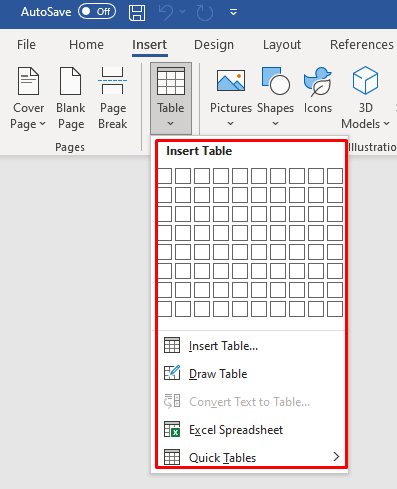
- With the cursor, select the first grid cell and slide it down to select the number of columns and rows you want. As an example, choose six columns and four rows.
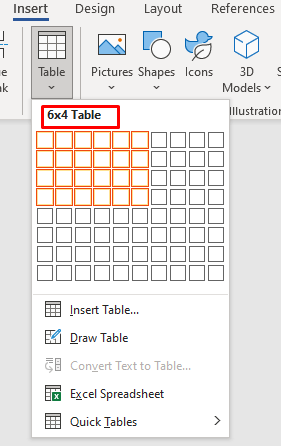
- The table will be automatically created in the document.
Once there’s a table in your document, you’ll notice two new tabs on the ribbon: Table Design and Layout . You can use these tabs to modify and stylize your newly created table. More on that later.
Create a Table with the Insert Function
Using the insert function is as easy as selecting your table layout from the grid. Here’s how it works:
- Go to Insert , then press on Table .
- Instead of dragging your cursor to select the grid, select Insert Table from the menu just below the grid.
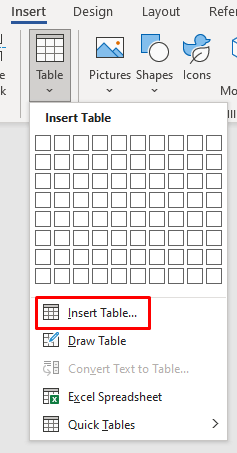
- A dialog box will appear where you can enter the number of rows and columns you want in your table under the Table Size panel. In the AutoFit Behavio r panel, select Auto . You can also experiment with other options to see how you like them. AutoFit to Contents will produce a narrow column that changes in size as you enter data. AutoFit to Window will expand your table to fit the size of your document.
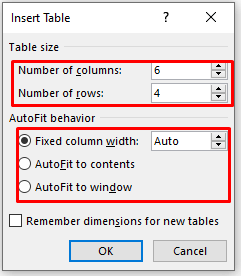
- If you want your future tables to remain this size, check the Remember dimensions for new tables option. Click the OK button to finish and create a table.
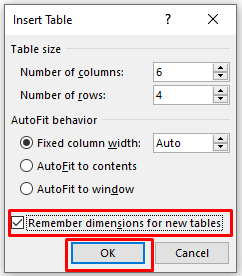
Draw a Table
You can manually draw a basic table in Word. Here’s how:
- Go to Insert , select the Table button, and choose Draw Table from the menu below the Grid.
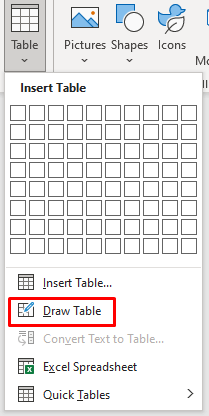
- Your cursor will turn into a pencil. Drag it down and across the document to draw a box. You don’t have to worry about the dimensions; you can modify them later.
- Now you can start drawing cells and columns inside it. Simply drag the cursor to draw them one at a time.
- If you need to add or remove columns or rows later, you can go to the Layout tab and select the Draw Table or Eraser button. This’ll allow you to continue drawing lines with a pencil cursor or to erase existing lines with an eraser cursor.

Insert a New Excel Spreadsheet in Word
You can create an Excel spreadsheet directly in Word . Follow these simple steps:
- Go to Insert , select Tables , and choose Excel Spreadsheet from the menu.
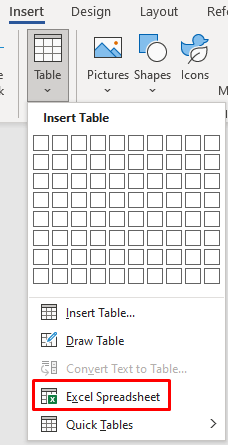
- The new spreadsheet will be created where your cursor is set.
- Excel’s menu and commands will also be available to you, and you can use them to edit your table.
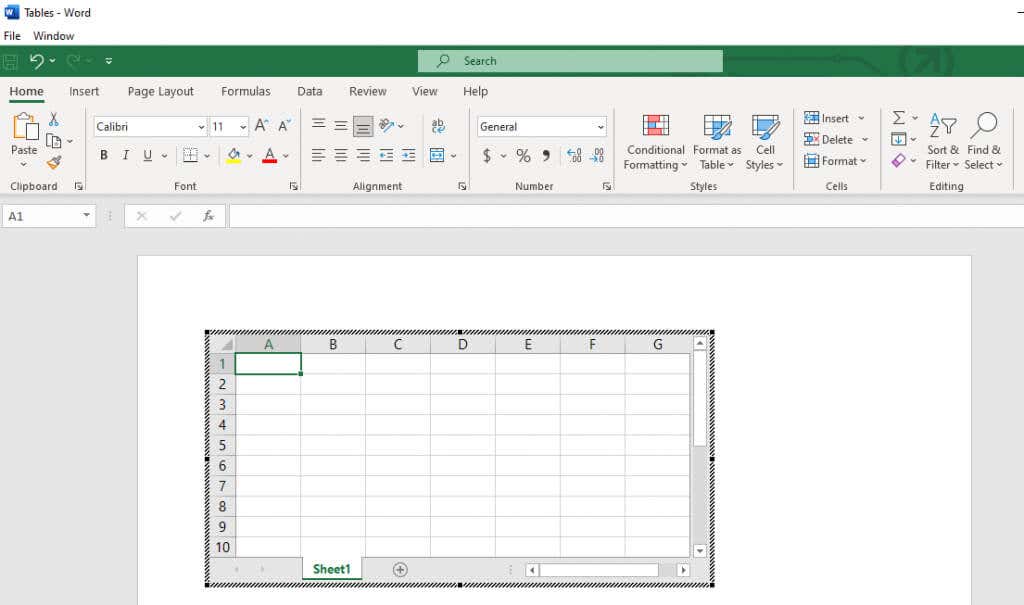
Copy and Paste an Existing Excel Spreadsheet
If you have prepared data in an Excel spreadsheet but need to move it to your Word document, you can simply copy and paste it.
- Open your Excel Worksheet, highlight the spreadsheet you need, and select the Copy button.
- Open Word and position your cursor where you need to insert the spreadsheet.
- Select the Paste drop-down menu on the Home tab in Word and choose Keep Source Formatting .
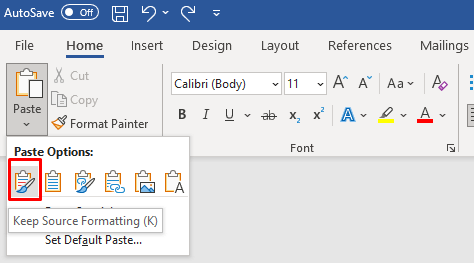
- You can also right-click your mouse and select Keep Source Formatting under Paste Options.
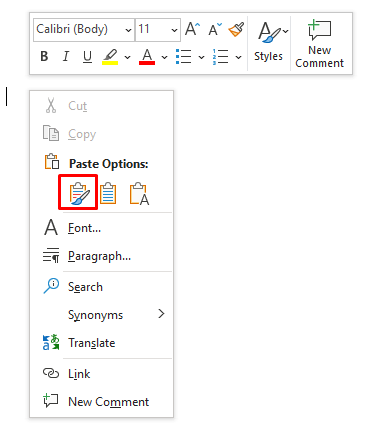
Quick Tables
If you don’t want to customize your tables, choose one of Word’s templates from the Quick Tables menu. You can also create your own design and save it in the Quick Tables Gallery for later use.
- Go to Insert , then select Tables , and Quick Tables .
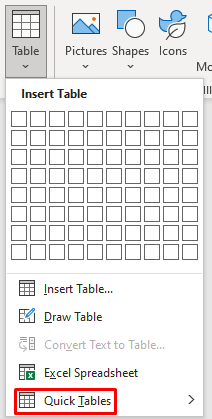
- Select the template from the Quick Tables menu that fits your project.
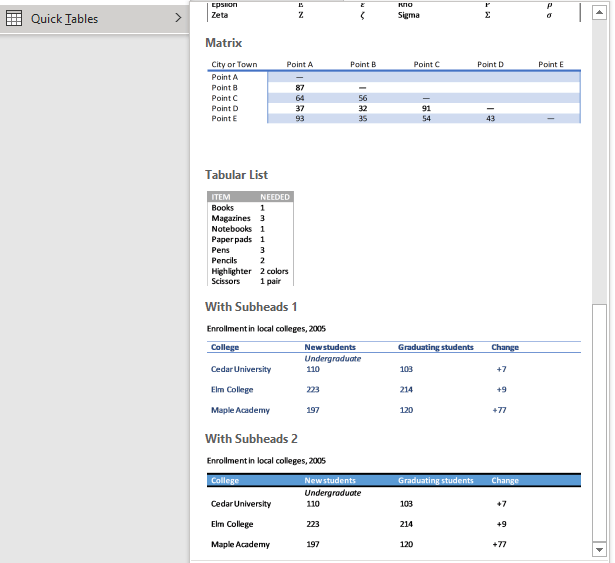
- You can continue modifying it if you want to change the details.
Convert Text to Table
Converting text to a table used to be messy in Word. The data in a table would end up misplaced. That’s because previously, we had to use tabs to separate the data in individual cells.
Microsoft improved this feature, and now you can separate the table fields with commas, paragraphs, or any other separation characters. Let’s see how to convert a simple grocery shopping list into a table.
- Enter your data in a Word document. Remember to separate each data entry you want into individual cells with a comma. The rows will be separated by hitting enter and starting a new paragraph. Your list should look something like this:

- Select the list, go to Insert , Tables , and choose the Convert Text to Table option.

- In the dialog box, make sure that Commas are selected under the Separate text at the panel. Then click OK .

- Word will do the conversion for you, and a table will appear. You can then use the Table Design and Layout tabs to modify it.
How to Customize a Table
Table Design and Layout tabs are filled with helpful table tools you can use to format tables. Use Table Design to stylize your table and change its looks. Here you’ll find tools for shading, painting borders, and setting their thickness, style, and color. You can also select one of the many offered table styles.

In the Layout tab, you’ll find tools to add or remove cells, rows, and columns, merge cells, split them, or split the whole table into several ones. You’ll also use this tab to set other table properties, such as the table’s dimensions, or to align the text.

However, there are quicker ways to achieve anything these tools allow you to do. Let’s see how to quickly resize, align, add, or remove columns, rows, cells, and much more in Word tables.
How to Resize a Microsoft Word Table
Resizing the table manually means you can adjust its size or modify rows and columns individually. It’s as easy as dragging and dropping.
Resize the Whole Table
You’ll have to grab and drag to make the entire table larger or smaller.
- Select your table.
- Grab the little square that appears at its bottom-right corner.

- Drag the table to the size you want.
Resize a Column or a Row
Adjusting only the column or a row is just as easy.
- Place your cursor over a column or a row border until you see a double-sided arrow. The arrows will face left and right for columns and up and down for rows.

- Click and drag the arrow right or left to resize a column and up and down to resize a row.
- When you are done, simply release the mouse button.
How to Align the Table in MS Word
You can align your table to the left, center, or right to best fit your Word document. This is especially useful if you resize the table to fit text around it. Here’s how:
- Select the table and go to the Home tab.
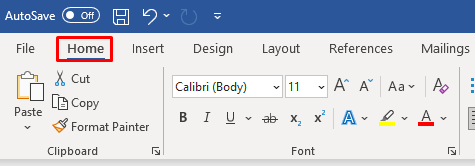
- In the Paragraph section you’ll find Align Left, Center, and Right buttons. Use them to align your table.

How to Insert or Remove Columns and Rows
If your table has too few or too many rows and columns, you can easily fix it.
Add Columns and Rows
Adding a single column or a row is simple:
- Place your cursor on top of the columns or on the left side of the rows until a plus sign appears.
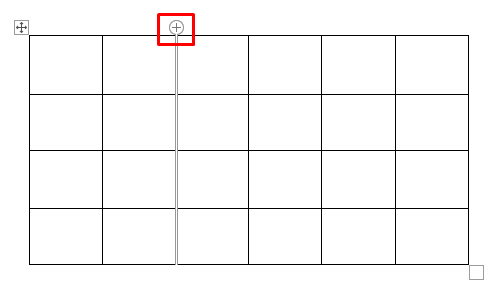
- Click this plus sign to add a new column or row.
If you want to insert multiple rows and columns:
- Select the same number of already existing rows or columns (if you want to add two columns, select two existing ones).

- Right-click, then go to the Insert menu and select to insert columns to the left or right and rows above or below.
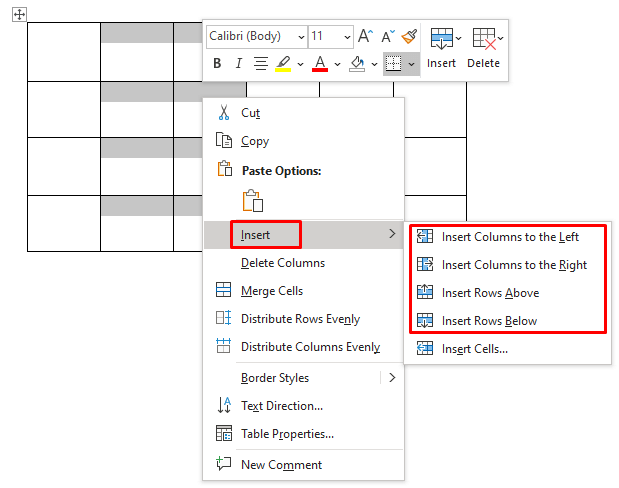
Remove Columns or Rows
To delete rows or columns, select them, right-click, and select Delete Columns (or rows).
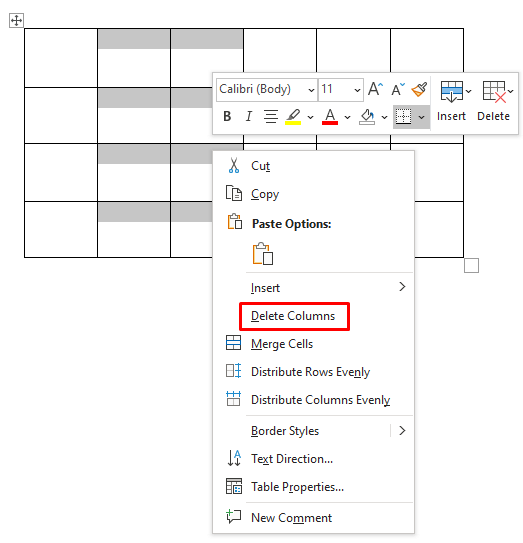
How to Add Borders or Shading
Table borders and shading are crucial to making your table look professional. With these simple tools, you can make your table stand out and make it easier to read. You’ll find both tools in the Table Design tab.
Adding Borders
Go to the Table Design tab and:
- Click Borders . A drop-down menu will let you choose the type of borders you want to add. Add them around each cell, or only highlight the outside of the table with borders. Place the cursor over the options, and you’ll get a preview of how each one changes your table.

- Once you decide on the border style, click it to apply it to your table.

- To place borders around a specific cell, row, or column, first select it and then choose the border style.
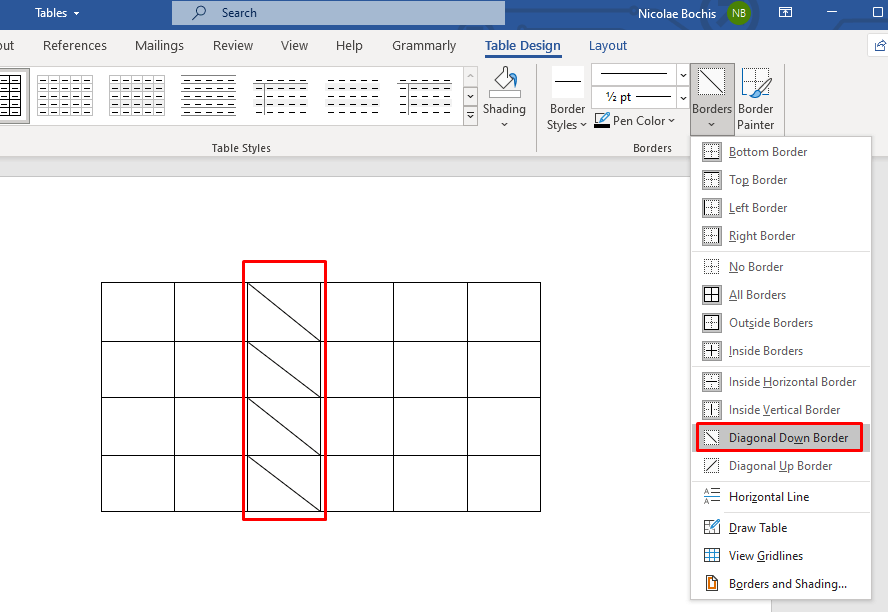
Add Shading
Spice things up by adding a background color to your tables . Use the shading drop-down menu to choose a color with which you’ll shade your table. You’ll find it in the Table Design tab.

If you want to shade a specific row, column, or cell, first select it and then choose the color. You can also shade only the selected cells.

How to Apply a Style
Microsoft Word has many table styles to offer, and you can choose one to make your table look professional. You can also do this to skip adding border style and shading.
- Select the table and go to the Table Design tab.
- Locate the Table Style box at the top of the window, and use the up and down arrows, or the “More” arrow, to browse the gallery.

- If you place your cursor over a specific style, you’ll see its preview on your table.
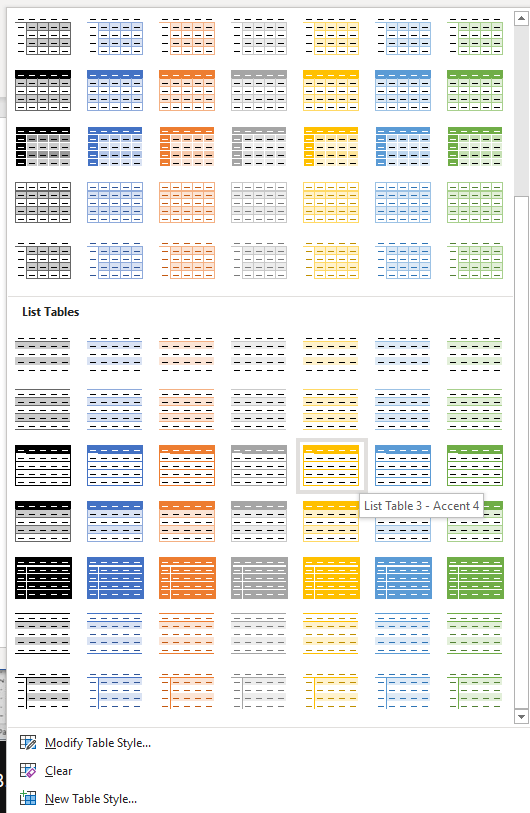
- Click on the selected style to apply it to your table.
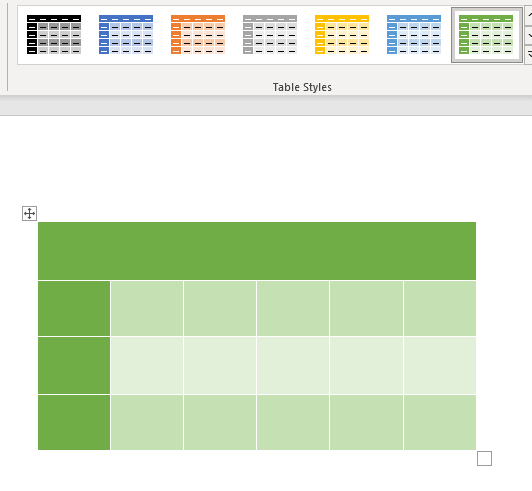
To adjust the premade table style, go back to the Table Design tab and check or uncheck the boxes in the Table Style Options section. By doing this you can add or remove the Header Row, First Column, or Banded rows. There are more options so you can experiment with them and see how they influence your table design.

Use Table Properties
If you need to set a specific row height and a column width, you should use Table Properties. Here’s how:
- Select your table and right-click it. Then, choose Table Properties from the menu.

- When a dialog box opens, use the Table , Row , Column , Cell , and Alt Text to adjust their size, text wrapping, alignment, and more.
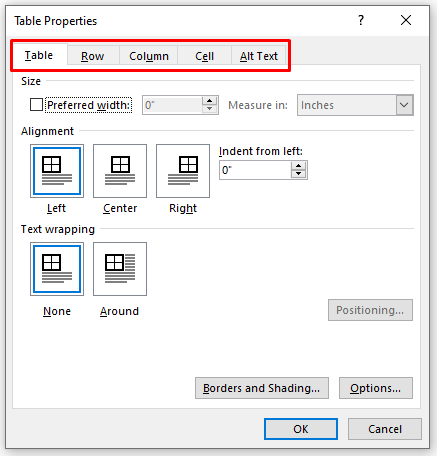
- When you’re done with adjustments, click the OK button to apply them to your table.
Word offers you a lot of tools, but creating and customizing tables is a quick and easy task. Not only can you use the pre-formatted table templates, but you can also easily customize your own table based on the needs of your project. Whether it’s adding new rows or columns for different parts of your data or varying the widths and heights of cells, you have all the tools you need to create a professional table. Let us know in the comments below if you have any questions!
Nicolae is a Jack of all trades technology writer with a focus on hardware, programming languages, and AI image-processing software. Over the last five years, he has ghostwritten numerous tech how-to guides and books on a variety of topics ranging from Linux to C# programming and game development. Nicolae loves everything that has to do with technology and his goal is to share his knowledge and experience with others. Read Nicolae's Full Bio
Read More Posts:

Module 5: Microsoft Word, part 3
Assignment: create document with tables and images.
For this assignment, you will format a document with a table and an image. Follow the directions, then submit your assignment. If you get stuck on a step, review this module or previous modules and ask your classmates for help in the discussion forum.
- Download the report document and open it in Microsoft Word.
- Save the document as BA132_LastName_Report.docx , replacing “LastName” with your own last name. (Example: BA132_Hywater_Newsletter). It is a good idea to save your work periodically.
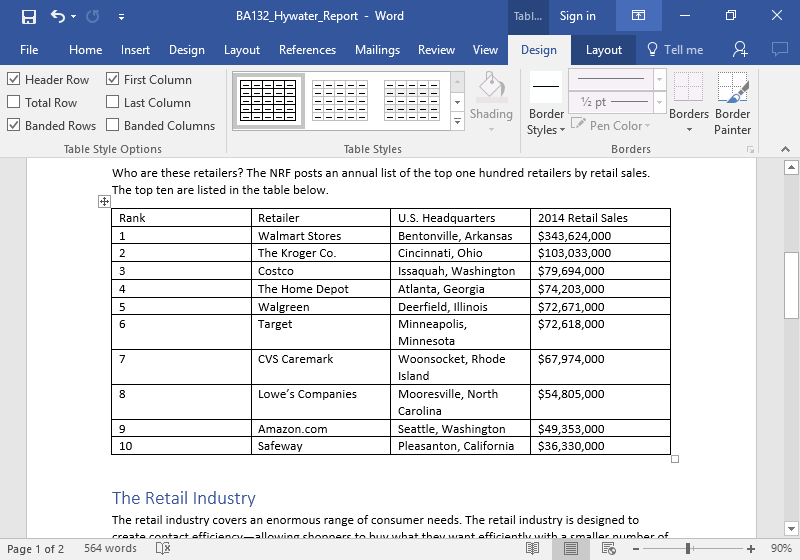
- Insert the graph image into your document after “creating greater contact efficiency for consumers.”
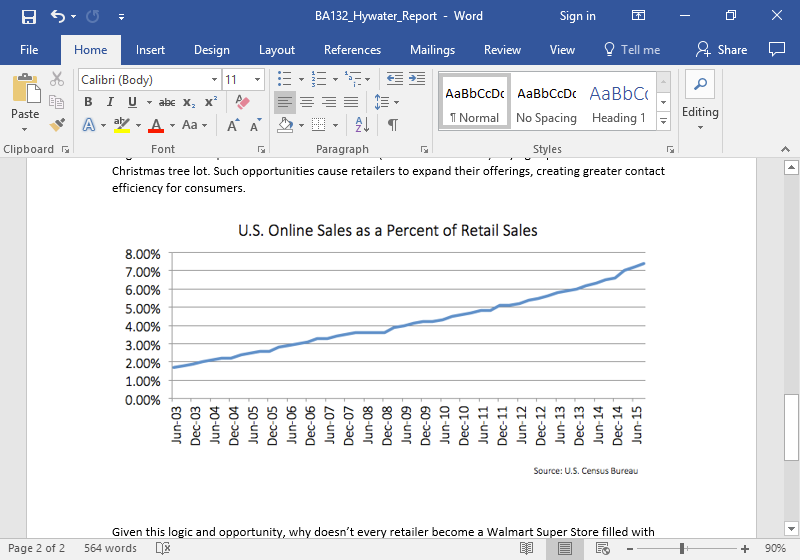
- Save your document again and submit your work to Canvas.
- shopping-business-retail [used in report document]. Authored by : Alexas_Fotos. Located at : https://pixabay.com/en/shopping-business-retail-1165437/ . License : CC0: No Rights Reserved
- Reading: Types of Retailers. Authored by : Lumen Learning. Located at : https://courses.lumenlearning.com/marketing-spring2016/chapter/reading-types-of-retailers/ . License : CC BY: Attribution
- Assignment: Report. Authored by : Lumen Learning. License : CC BY: Attribution
- The Retail Industry [used in report document]. Authored by : Lumen Learning. Located at : https://courses.lumenlearning.com/marketing-spring2016/chapter/reading-define-retailing/ . License : CC BY: Attribution
- Outcome: Retailers As Channels of Distribution. Authored by : Lumen Learning. Located at : https://courses.lumenlearning.com/marketing-spring2016/chapter/outcome-retailers-as-channels-of-distribution/ . License : CC BY: Attribution

- Skip to main content
- Skip to secondary menu
- Skip to primary sidebar
- Skip to footer
Erin Wright Writing
Writing-Related Software Tutorials
Three Ways to Insert Tables in Microsoft Word
By Erin Wright
This tutorial shows three ways to insert tables in Microsoft Word so you can choose the method that is most appropriate for your content:
- Create a table from the Table menu (best for general use)
- Create a table from the Table dialog box (offers the most sizing options)
- Insert a Quick Table (fastest setup)
Note that you can also draw a custom table and import a table from Excel .
Don’t miss the five tips for working with tables at the bottom of this tutorial:
- How to delete a table
- How to resize an entire table
- How to resize individual rows and columns
- How to add rows and columns
- How to add color to a table
This tutorial is also available as a YouTube video showing all the steps in real time.
Watch more than 250 other writing-related software tutorials on my YouTube channel .
The images below are from Word for Microsoft 365.The steps are the same in Word 2021, Word 2019, and Word 2016 and similar for Word 2013 and Word 2010. However, your interface may look slightly different in those older versions of the software.
Method 1: Create a Table from the Table Menu
This method is appropriate for most users who want to create a basic table for general use.
- Place your cursor where you want to insert the table.
- Select the Insert tab in the ribbon.

- Select the Table button in the Tables group.

- Move your pointer across and down the grid to select the number of cells (organized as rows and columns) needed in your table.
The selected cells will turn orange.

- Click the selected (orange) part of the grid or press Enter on your keyboard to insert the table.
Method 2: Create a Table from the Table Dialog Box
This method provides advanced sizing options.
- Select the Insert tab in the ribbon (see figure 1).
- Select the Table button in the Tables group (see figure 2).
- Select Insert Table from the drop-down menu.

- Enter the number of rows and columns in the Insert Table dialog box.

- Select an AutoFit behavior:
- Fixed column width can be set to Auto or a specific width between 1/100 inch and twenty-two inches using the increment arrows.
- AutoFit to contents adjusts cell sizes to the content.
- AutoFit to Window adjusts the width of the table to the viewer’s Word window or browser window.

- (Optional Step) Check Remember dimensions for new tables if you want to create the same size table in the future.

- Select the OK button to close the Insert Table dialog box and insert your new table.

Method 3: Insert a Quick Table
Quick Tables are prebuilt tables and calendars you can modify for your own use.
- Select Quick Tables from the drop-down menu.

- Select a table from the gallery.

- Add your own content by typing over or deleting the table’s example text.
Now let’s look at some tips for working with tables.
Five Tips for Working with Tables in Word
The following tips cover the basics of working with tables. We will dive into this topic in much greater detail in a separate tutorial.
Tip 1: How to Delete a Table
- Select the table selector, which looks like crossed arrows, to select the entire table. You may have to hover your pointer over the table to reveal the table selector.

- Right-click the table.
- Select Delete Table from the shortcut menu.

Tip 2: How to Resize an Entire Table
- Click and hold the resizing handle in the bottom right of the table. You may need to hover your pointer over the table to reveal the handle.

- Drag the table to the size you want and then release the handle.
Tip 3: How to Resize Individual Rows and Columns
- Hover your pointer over a row or column border until your pointer becomes two lines with two arrows.
Note that the pointer in figure 14 is enlarged to make it easier to see. Your pointer will be smaller.

- Click and hold as you drag the border to resize the row or column.
Tip 4: How to Add Rows and Columns
- Right-click inside a cell.
- Select Insert from the shortcut menu.

- Select the location of your new row or column:
- Insert Columns to the Left
- Insert Columns to the Right
- Insert Rows Above
- Insert Rows Below
- Insert Cells

If you select Insert Cells, a dialog box will appear asking where you want to insert your new cells. Note that regardless of your answer, you will be inserting an entire row or column, not an individual cell.

Tip 5: How to Add Color to a Table
- Select the table selector, which looks like crossed arrows, to select the entire table (see figure 11). You may need to hover your pointer over the table to reveal the table selector.
- Select the Table Design tab in the ribbon. (Note that this tab only appears in the ribbon when a table is selected.)

- Select the down arrow in the Table Styles group.

- Select one of the styles from the gallery.

Alternatively, you can use the shading menu to add custom colors to individual rows and columns.

Pro Tip: For even more customization, add a background image to your table . Then, save your customized table as a template for reuse in future documents, as shown in “ How to Save Tables as Templates in Microsoft Word .”
Related Resources
How to Create and Customize Charts in Microsoft Word
How to Save Tables and Figures as Images in Microsoft Word (PC & Mac)
How to Insert Figure Captions and Table Titles in Microsoft Word
How to Change the Style of Table Titles and Figure Captions in Microsoft Word
How to Update Table and Figure Numbers in Microsoft Word
How to Create and Update a List of Tables or Figures in Microsoft Word
How to Export PDF Tables from Adobe Acrobat to Excel (PC & Mac)
How to Write Table Titles
How to Write Figure Captions for Graphs, Charts, Photos, Drawings, and Maps
How to Reference Tables and Figures in Text
Updated August 27, 2023
- Microsoft Word Tutorials
- Adobe Acrobat Tutorials
- PowerPoint Tutorials
- Writing Tips
- Editing Tips
- Writing-Related Resources

- Get started with computers
- Learn Microsoft Office
- Apply for a job
- Improve my work skills
- Design nice-looking docs
- Getting Started
- Smartphones & Tablets
- Typing Tutorial
- Online Learning
- Basic Internet Skills
- Online Safety
- Social Media
- Zoom Basics
- Google Docs
- Google Sheets
- Career Planning
- Resume Writing
- Cover Letters
- Job Search and Networking
- Business Communication
- Entrepreneurship 101
- Careers without College
- Job Hunt for Today
- 3D Printing
- Freelancing 101
- Personal Finance
- Sharing Economy
- Decision-Making
- Graphic Design
- Photography
- Image Editing
- Learning WordPress
- Language Learning
- Critical Thinking
- For Educators
- Translations
- Staff Picks
- English expand_more expand_less
Word - Tables
Word -, word tables.

Word: Tables
Lesson 23: tables.
/en/word/aligning-ordering-and-grouping-objects/content/
Introduction
A table is a grid of cells arranged in rows and columns . Tables can be used to organize any type of content, whether you're working with text or numerical data. In Word, you can quickly insert a blank table or convert existing text to a table. You can also customize your table using different styles and layouts .
Optional: Download our practice document .
Watch the video below to learn more about creating tables.
To insert a blank table:
- Place the insertion point where you want the table to appear.
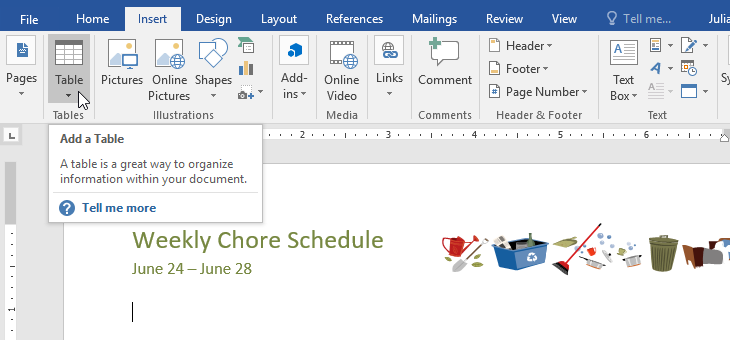
- Click the grid to confirm your selection, and a table will appear.
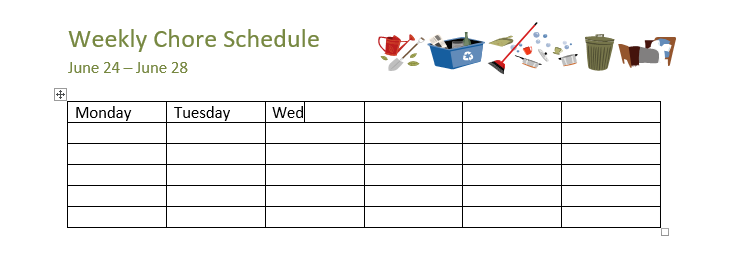
To navigate between cells, use the Tab key or arrow keys on your keyboard. If the insertion point is in the last cell, pressing the Tab key will automatically create a new row.
To convert existing text to a table:
In the example below, each line of text contains part of a checklist , including chores and days of the week. The items are separated by tabs . Word can convert this information into a table, using the tabs to separate the data into columns.
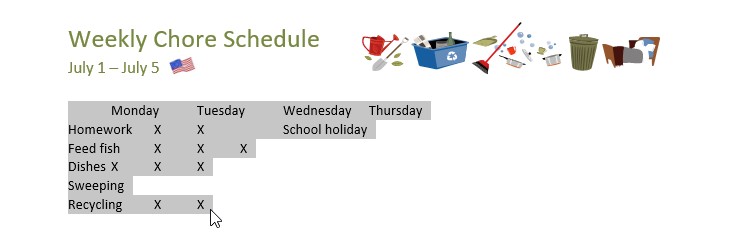
- Go to the Insert tab, then click the Table command.
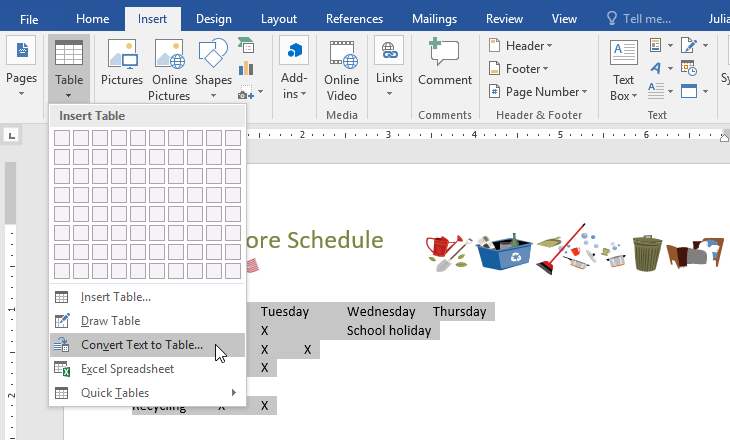
Modifying tables
You can easily change the appearance of your table once you've added one to your document. There are several options for customization, including adding rows or columns and changing the table style .
To add a row or column:

You can also right-click the table, then hover over Insert to see various row and column options.
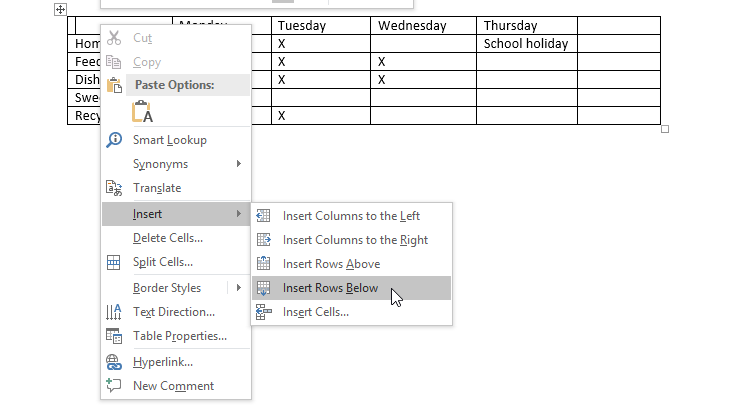
To delete a row or column:
- Place the insertion point in the row or column you want to delete.
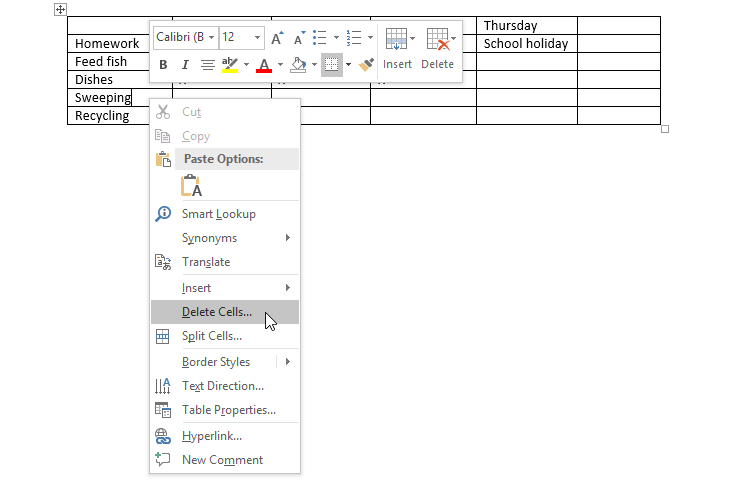
- The row or column will be deleted.
To apply a table style:
Table styles let you change the look and feel of your table instantly. They control several design elements, including color, borders, and fonts.
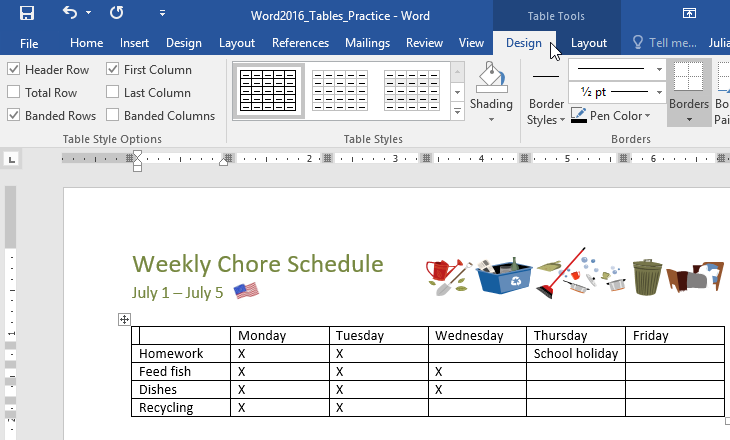
To modify table style options:
Once you've chosen a table style, you can turn various options on or off to change its appearance. There are six options: Header Row , Total Row , Banded Rows , First Column , Last Column , and Banded Columns .
- Click anywhere in your table, then navigate to the Design tab.
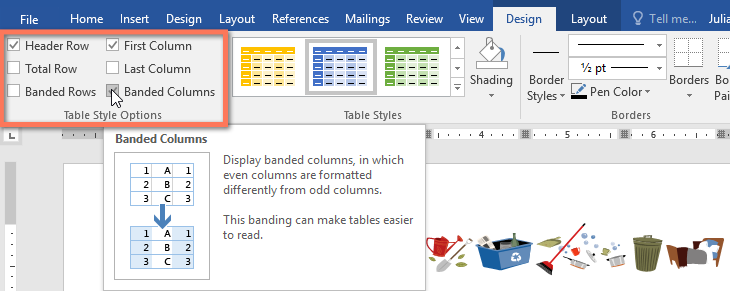
Depending on the Table Style you've chosen, certain Table Style Options may have a different effect. You might need to experiment to get the look you want.
To apply borders to a table:

- Click the drop-down arrow below the Borders command.
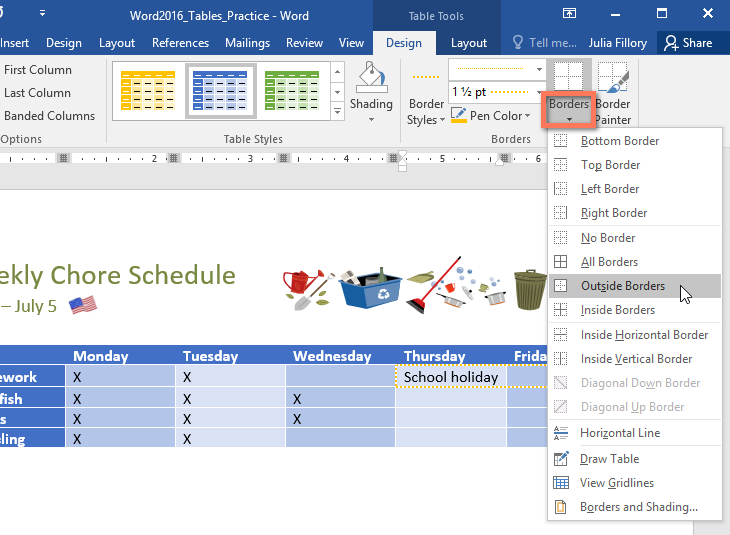
Modifying a table using the Layout tab
In Word, the Layout tab appears whenever you select your table. You can use the options on this tab to make a variety of modifications.
Click the buttons in the interactive below to learn more about Word's table layout controls.
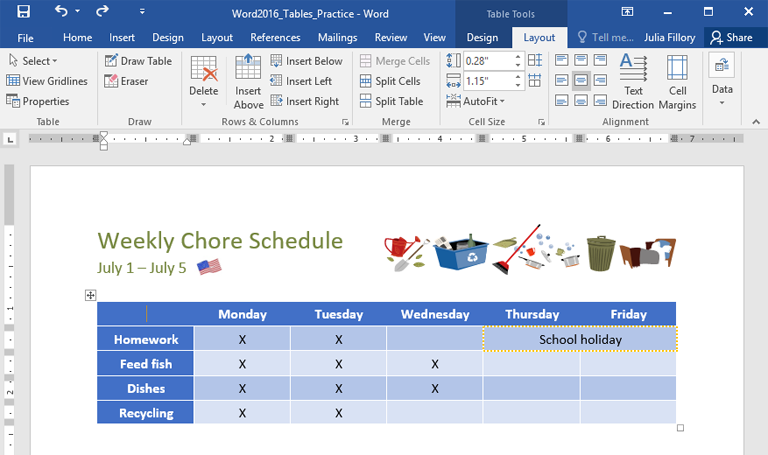
Rows and Columns
Use these commands to quickly insert or delete rows and columns. This can be especially useful if you need to add something to the middle of your table.
Merge and Split Cells
Some tables require a layout that doesn't conform to the standard grid. In these cases, you may want to merge multiple cells (i.e., combine them into one) or split a cell in two.
Change Cell Size
You can manually enter a desired row height or column width for your cells. You can also use the AutoFit command, which will automatically adjust the column widths based on the text inside.
Distribute Rows/Columns
To keep your table looking neat and organized, you may want to distribute your rows or columns equally . This will make them all the same size. You can apply this feature to the entire table or just a small portion of it.
Align Cell Text
By changing the alignment of your cells, you can control exactly where the text is located. In the example below, the text has been aligned to the center .
Change Text Direction
You can easily change the direction of your text from horizontal to vertical . Making your text vertical can add style to your table; it also allows you to fit more columns in your table.
- Open our practice document .
- Scroll to page 3 and select all of the text below the dates July 8 - July 12 .
- Use the Convert Text to Table to insert the text into a 6-column table. Make sure to Separate text at Tabs .
- Delete the Saturday column.
- Insert a column to the left of the Friday column and type Thursday in the top cell.
- Change the table style to any style that begins with Grid Table 5 . Hint : Style names appear when you hover over them.
- In the Table Style Options menu, uncheck Banded Rows and check Banded Columns.
- Select the entire table . In the Borders drop-down menu, choose All Borders .
- With the table still selected, increase the table row height to 0.3" (0.8 cm).
- Select the first row and change the cell alignment to Align Center .
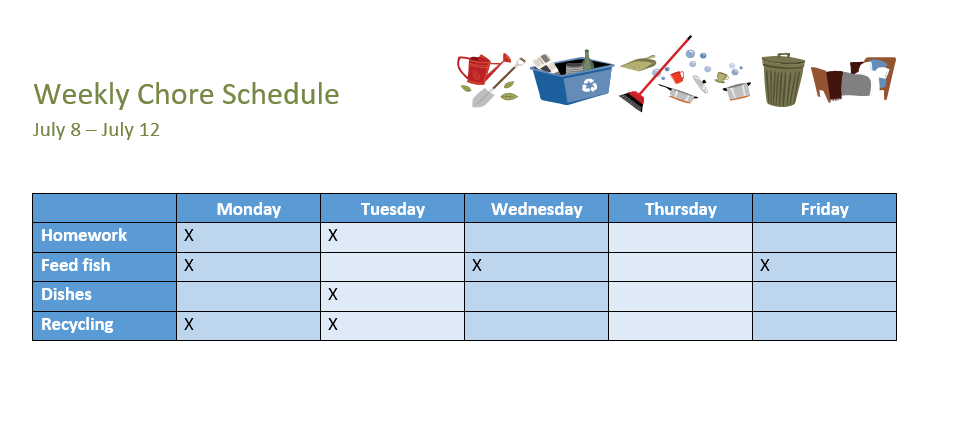
/en/word/charts/content/
8 Formatting Tips for Perfect Tables in Microsoft Word

Your changes have been saved
Email Is sent
Please verify your email address.
You’ve reached your account maximum for followed topics.
Slack Lists Are the Secret to Organizing Your Workload
You'll never use gmail the same way after applying these 5 gemini tricks, how to move windows to another drive: this is the easiest method.
On Microsoft Word, tables are essential formatting tools. Microsoft Office has made it easier to create and format basic tables in Microsoft Word for Office 365, Word 2019, Word 2016, and Word 2013.
We haven't covered tables as much as we would have liked to. It's time to correct that, as the number of people asking questions on how to format tables properly is piling up. Maybe these eight table tips can be an appetizer. You just cannot create beautiful Microsoft Word documents by cutting corners on tables—here's how to format tables in Word.
By the way, it's possible to get a free copy of Microsoft Word , should you need one.
1. How to Make a Table in Microsoft Word
Using tables, and even changing them on the fly according to the data, has become far easier in the newer versions of Word such as Microsoft Word 2019 and Office 365. Intuitive Microsoft Word table formatting features give you finer (and quicker) control over how a table looks. But first head to the Ribbon > Insert > Table > Insert Table for making your first table.
It gives you five options for creating your first table.
The quickest way to start is with Quick Tables . The built-in designs save you from the lack of design skills. You can modify the designs by adding your own rows and columns or deleting the ones you don't need.
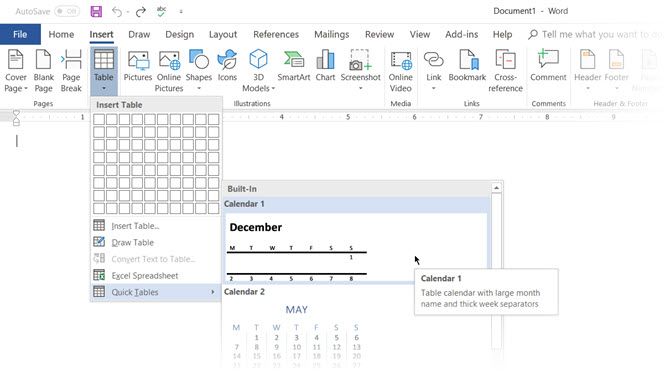
Another quick way to create a table in Word is the Insert Control feature. You can create a new column or row with one click. Hover the mouse over a table. A bar appears right outside your table between two existing columns or rows. Click on it when it appears, and a new column or row will be inserted at that position.

When you want to move or order a row around, use the combination of Alt+Shift+Up Arrow and Alt+Shift+Down Arrow to order the row up or down. Move contiguous rows by selecting them all first.
How to Use Table Properties to Position Your Table on the Page
If your tables are overlapping in Word, or you want to stop them from overlaying your text, then you need to learn how to position your tables on the page using the Table Properties feature.
Right-click on the table and select Table Properties from the context menu. The Table Properties dialog box is for precise control over the data and its display. Control the size, alignment, and indentation of the table.
By default, Word aligns a table on the left. If you want to center a table on the page, select the Table tab. Click on Alignment > Center .
The Indent from left figure controls the distance of the table from the left margin.
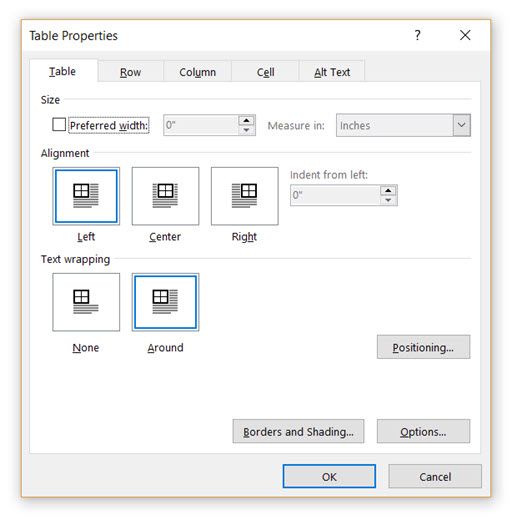
Position the table according to the text around it for a visually aesthetic look. Wrap text around tables by dragging it by the handle. The text wrapping changes automatically from None to Around . From the Table Positioning dialog box, you can set the Distance from surrounding text for each side of the table.
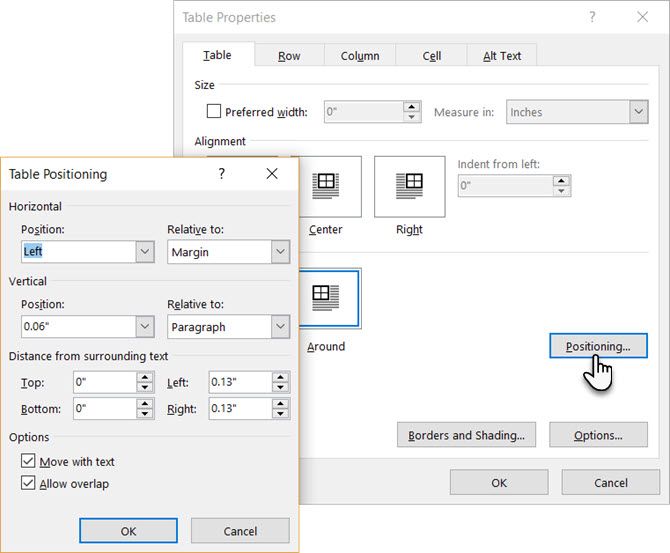
Select Move with Text if the text is directly related to the table data. The table is vertically aligned to the related paragraph around it. If the table data applies to the whole document, you can keep the option unchecked.
You can also control the tables with Microsoft Word keyboard shortcuts .
2. Use the Ruler
If you're looking for an easy way to make tables look good in Word, then sizing tables and positioning them accurately is an art in itself. If you need precise measurements to size your rows and columns— use the ruler .
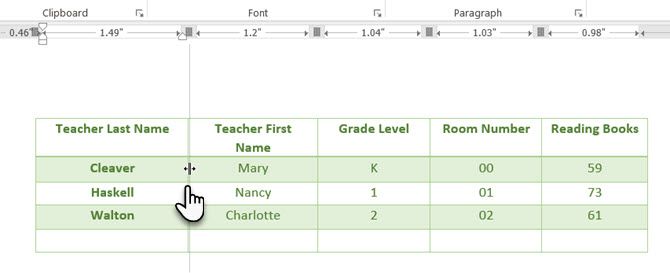
Hover the mouse over a border. When the double-arrow pointer appears, click the border and hold down the ALT key. Move the rows and columns to fit your measurements.
3. Convert Text to Table (and Vice Versa)
Tabular data gives information in its structure. It would have been frustrating if Word didn't have something to handle non-tabular data. You can convert data to tables instantly from the Insert Table command.
Select the text. Go to Ribbon > Insert > Table > Insert Table .
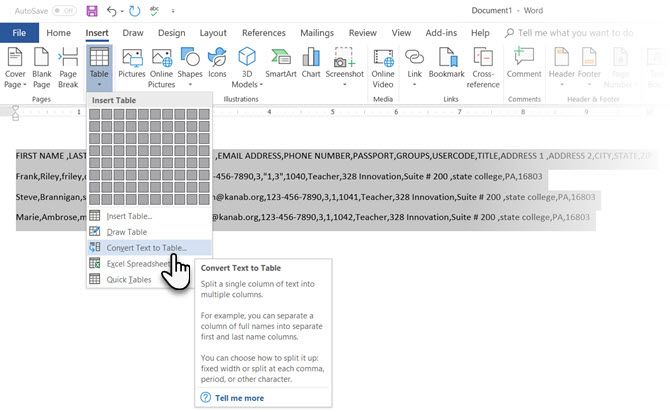
Microsoft Word determines the required number of rows and columns by considering the text separators and then auto-fits the contents. The Convert Text to Table dialog box allows you more control if the previous operation doesn't work out right. You can also choose how to fit the contents of the table on the page.
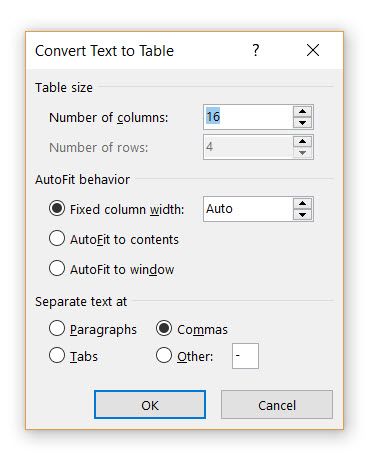
You can specify how Microsoft Word should separate the data into rows and columns. Paragraph, tabs, commas, or any other delimiting character. This allows you to easily import non-tabular data from CSV files or plain TXT files and convert them into formatted tables. Remember, you can also import data from Microsoft Word into an Excel spreadsheet.
Convert Table to Text
Engineer the reverse process if someone asks you to send them files with comma-separated values or any other delineator. Select the entire table by clicking the “move” handle above the table.
Go to Ribbon > Table Tools > Layout > In the Data Group , click Convert to Text .
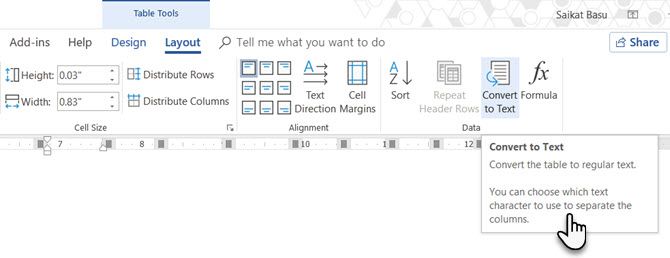
Simple text can be boring. When you have the chance, convert your table of data to a more visual chart instead with one of the underused features in Microsoft Word .
4. Auto-Fill Column Numbers
Microsoft Excel makes auto-filling a sequence of numbers very easy. Microsoft Word does not, and you may have to resort to a manual job. There is a simpler way.
Create a new column for the serial numbers if it does not exist. Select this column by positioning the mouse over the column.
With the column selected, go to Home > Paragraph > Click the Numbering button for inserting a numbered list.
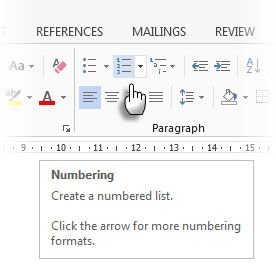
A number sequence is inserted in the column automatically.
5. Freeze Those Tables!
Microsoft Word tables change their dimension to accommodate new data. There may be times when you do not want the table to change size at all, even when new data is inserted. That is—“freeze” the size of cells.
The first step is to specify a fixed size for the cells. Go to Table Properties > Row > Enter a value in the Specify height box. For Row height is select Exactly from the dropdown.
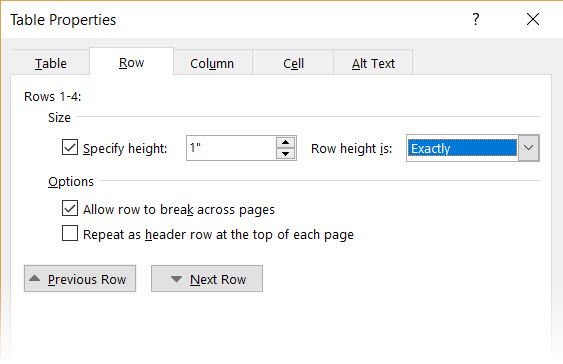
Now, select the Table tab > click the Options button > uncheck the Automatically Resize to Fit Contents check box.
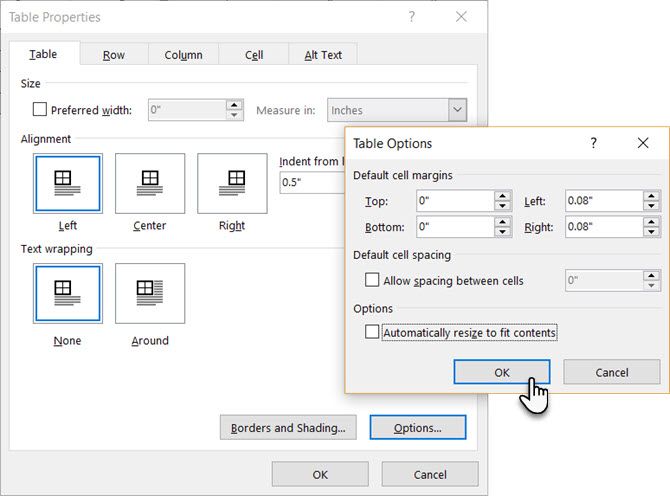
Click OK twice to exit the Table Properties dialog box.
This also solves the problem of inserting an image into a cell without the cell expanding to accommodate the image. If the image is bigger than the available space in the cell, it gets cropped to fit within the cell.
6. Change Rows Into Columns in a Table
There are situations where you have to change rows into columns and columns into rows. One possible scenario is where the number of columns exceeds the page margin. Switching columns around to rows and vice-versa is called transposition .
The bad news is that Word does not have an inbuilt method for handling this yet. Microsoft suggests that you copy-paste your table into Microsoft Excel and use its Transpose command. The transposed table can now be copy-pasted back into Microsoft Word.
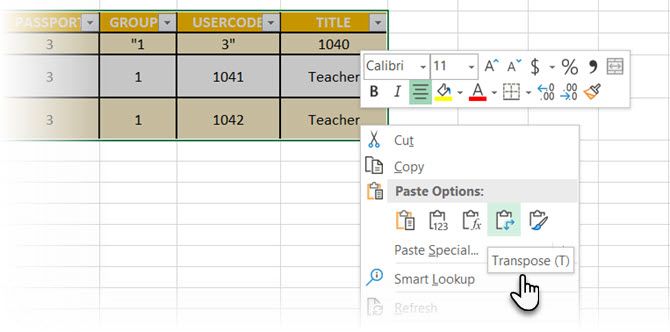
Data shows how easy it is in Excel with this short tutorial on switching rows into columns . Also, take the help of Microsoft's Support Page if you run into a problem using the Transpose command.
7. Paste Perfect Excel Tables Into Gmail
You will find a use for this simple workaround. By default, Gmail does not retain the spreadsheet format when you paste from Microsoft Excel. To email tabular data without sending it as a separate attachment, use Microsoft Word as a bridge.
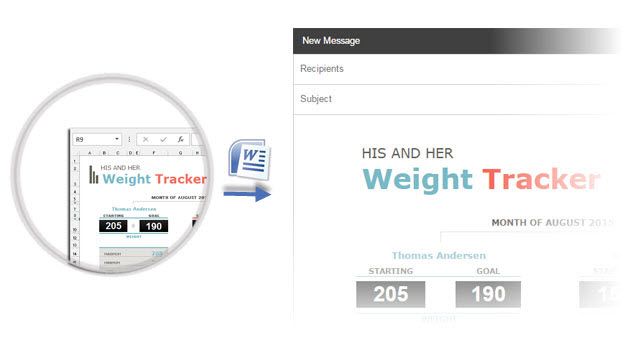
Select and copy-paste the Microsoft Excel table to a Microsoft Word document with the source formatting. Now, copy-paste from Microsoft Word to Gmail. As you can see from the screenshot, the problem is solved. You might have to tweak the more heavily formatted tables slightly, but most of the formatting is retained.
8. Reuse Your Tables to Save Time
You can save a lot of time by re-using tables in your professional Microsoft Word documents. Save empty table formats and insert new data when required. With this quick save, you won't have to recreate the layout from scratch for new data.
Select a table. Go to Ribbon > Insert > Text group > click Quick Parts > Save Selection to Quick Part Gallery .
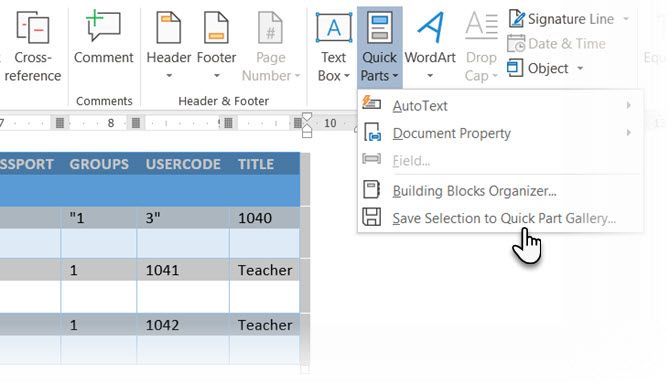
After you save a selection to the Quick Part Gallery, you can reuse the selection by clicking Quick Parts and choosing the selection from the gallery.
Use the Building Blocks Organizer to preview any table you created. You can also edit properties and delete the tables from here.
Do Microsoft Word Tables Confuse You?
These tips aren't enough to cover the scope of formatting tables in Word. I haven't talked about the role of the Design tab in creating eye-catching tables. That is a topic in itself. But it is one of the lesser areas to get confused over thanks to the visual help in that tab.
Working with tables in Word can be extremely rewarding. While tables are one common area between Microsoft Word and Excel, Microsoft Excel is more for power managing tabular data. Nonetheless, learning how to format tables well in both applications is an essential Microsoft Office skill. Use them at every opportunity.
- Productivity
- Microsoft Word
- Microsoft Office 2013
- The making of an Office Legend
- Choose what you pay
- Free Training
- Computers for the Terrified!
- Beginners Word Bootcamp
- Word Mastery
- Beginners Excel Bootcamp
- Excel Mastery
- PowerPoint Mastery
- Outlook Mastery
- Publisher Mastery
- Office Legends Academy
- Member Login
Reading Time: minutes remaining
How to Create & Manipulate Tables in Word

by Jason Morrell May 10, 2021
Tables in Word are useful in so many situations. In this post you'll discover how to create tables, then manipulate and design them in the quickest and easiest way to provide that visual punch.
RELATED POST :
Enhance your Word tables with these advanced features
1. What are tables in Word good for?
Tables are useful for 2 distinct reasons.
- To show an actual table of data, or
- To organise and postion text, images and other elements on the page.
Many years ago, typewriters ruled the world. And a feature of a good typewriter was the tab stop , which was a device that essentially let you control indentation.
Over the years many people have continued to use tabs to indent text, because of its convenience, but they are hard work to set up properly.
Tables provide a much easier way to organise content on a page.
2. How to create TABLEs in Word
1. Select the Insert tab.
2. Click the Tables icon in the Tables group.
3. Move your mouse pointer into the table grid until the required number of rows and columns are highlighted orange, then left-click.
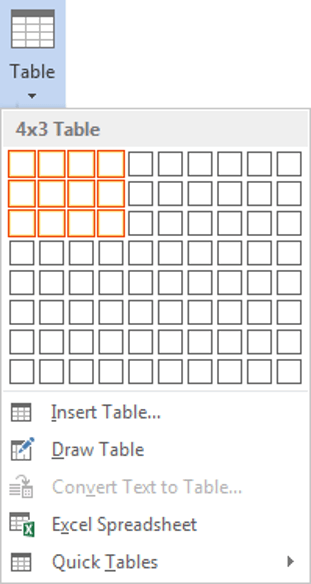
An empty table is inserted into the document.
Two new tabs, Design and Layout are also added to the ribbon area, under the banner of Table Tools .

3. MOVING AROUND A Word TABLE
- While the table is empty, you can use the cursor keys to move around the cells. However, when the cells contain information, using the cursor keys will move through the cell content first before moving to the next cell
- You can left-click in any cell to position the cursor.
- Press Tab to move to the next cell. The cursor will move across and then down the table.
- Press Shift + Tab to move to the previous cell.
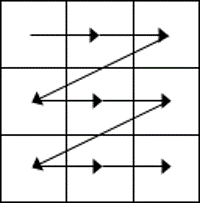
NB. Using Tab is better than using the cursors as it will move to the next/previous cell regardless of whether there is information in the cells.
NB2. If you press Tab while you are in the last cell, a new row will be added to the bottom of your table
4. SELECTING A CELL, ROW, COLUMN OR THE ENTIRE TABLE
To select a cell:
1. Position the mouse pointer inside the cell on the bottom-left corner of the cell. The pointer will change shape to a solid black arrow that points up and right.
2. Left-click.

To select a row of a table:
1. Position the mouse pointer in the left margin in line with the row you want to select. The mouse pointer will change to a white arrow that points up and right.

To select a column
1. Position the mouse pointer so that it rests on the top border of the table, above the column you want to select. The mouse pointer will change to a solid black arrow pointing down.

To select the entire table:
1. Position your mouse pointer over the 4-headed arrow icon situated at the top-left of the table.
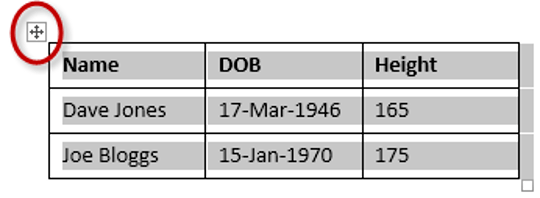

5. INSERTING AN EXTRA ROW OR COLUMN
To insert an extra row:
1. Position the cursor in a cell.
2. Select the Layout tab, under the Table Tools banner.
3. Click Insert Above or Insert Below in the Rows and Columns group
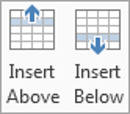
Here is a quick way to insert new rows:
1. Position the cursor to the left of the table, but in close proximity.
2. A plus symbol will appear above or below the mouse pointer indicating where the new row will be added.

3. Nudge the mouse pointer up or down to move the plus sign above or below.
4. Left-click to insert the new row,
To insert an extra column:
3. Click Insert Left or Insert Right in the Rows and Columns group

Here is a quick way to insert a new column:
1. Position the cursor above a column, but in close proximity to the table.
2. A plus symbol will appear to the left or right of the mouse pointer indicating where the new column will be added.
3. Nudge the mouse pointer left or right to move the plus sign to the left or the right of the column.
4. Left-click to insert the new column,

6. DELETING A ROW OR COLUMN
To delete the current row or column:
1. Position the cursor in any cell of the row you want to delete.
3. Click the Delete icon in the Rows and Columns group.

4. Choose Delete Row or Delete Colum n from the drop-down menu.
7. Quickly fORMATTING tables in Word
Word provides you with a number of pre-set table designs. This means that it formats the headings and the data, applies a variety of borders and colours the cells in a way that makes it look like a professionally produced table. As a beginner this simple technique will give you a good-looking table.
1. Position the cursor in any cell in the table.
2. Select the Design tab under the Table Tools banner.
The Table Styles group lists a number of table designs. To get the full list, click the More button beneath the table styles scroll bar
The default table style is Table Grid in the Plain Tables category which adds simple gridlines but no shading to your table.
Live Preview allows you to hover over a design and see it applied to your table. If you like what you see, click to select the table design.

In the Table Style Options group of the Design tab, tick the components that you have in your table. For example, if your table has column headings, tick Header Row . In doing this, the various parts of your table are formatted accordingly

Header Row This will emphasise the header row by making the text bold or applying a different cell colour (depending on the table style selected.
Total Row This will emphasise the bottom table row by making the text bold or applying a different cell colour (depending on the table style selected.
First Column This will emphasise the first column (for labels etc.) by making the text bold or applying a different cell colour (depending on the table style selected.
Last Column This will emphasise the last column (for row totals etc.) by making the text bold or applying a different cell colour (depending on the table style selected.
Banded Rows This will make odd rows one colour and even rows a different colour. This helps readability.
Banded Columns This will make odd columns one colour and even columns a different colour. This helps readability.
8. SETTING THE BORDERS AND SHADING
The Table Styles Gallery allows you to completely format a table with one click. Whereas you used to need some nous, anybody can now create a professional looking design.
However, you will often still need to apply your own border and shading, and manually change a table design. With a little effort can add a lot of flavour to your page and dramatically enhance the overall appearance of the document.
To set the borders for tables in Word:
1. Select the portion of the table that you wish to set the borders for. This may be the entire table, a row or rows, a column or columns or a selection of cells.
3. Select the Borders icon. A drop-down list appears. This list shows every combination of border that can be turned on or off. The icons with a shaded background are currently switched on. The rest are switched off.
4. Click any icon to switch the border on or off. The border style that is applied is the default style ( ½ pt solid black line ) or the last style that was used.
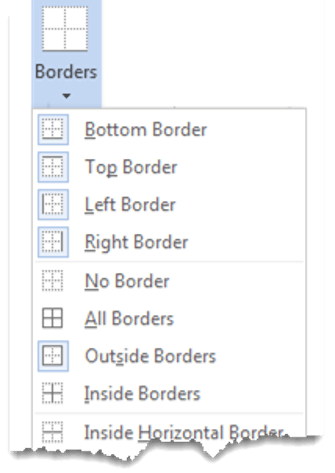
5. To apply customised borders, with different colours, styles and widths, click the Borders & Shading option at the bottom of the list to display the Borders and Shading dialog box.
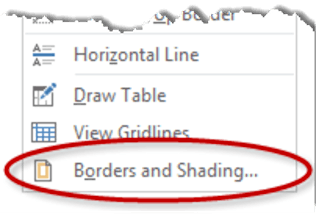
Your selection will always have an outer border, and if you selected more than one cell, you will have some inside borders as well. The easiest way to use the dialog box is to start on the bottom-middle and work your way up and right.
1. Select the colour and width (thickness) that you would like for your border.

2. Choose a style (e.g. dotted, dashed, double, solid etc.)

3. Paint your borders. There are two ways to do this.
- The first way is to click directly on a border in the Preview itself.
- The second way is to click the appropriate icon around the edge of the Preview section that represents each border. Depending on which cells you selected in your table, some of these icons may not be available.

On the left-hand side of the dialog box, there are some pre-defined border combinations which you can use to save yourself some time. Depending on your selection of cells, the pre-defined options may differ. Here’s a run-down:
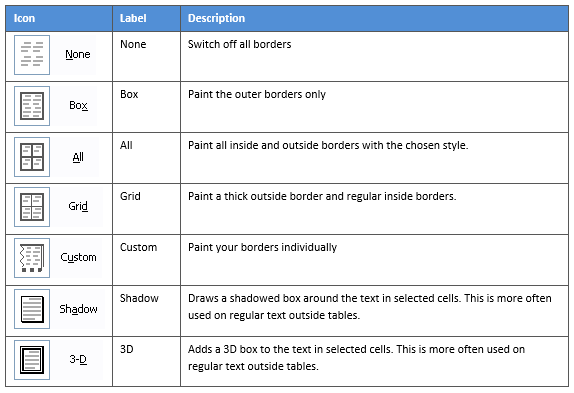
To shade the cells of tables in Word:
1. Select the portion of the table that you wish to shade. This may be the entire table, a row or rows, a column or columns or a selection of cells.
3. Click the Shading icon. The colours that you see displayed match the current them of the document. Themes were discussed earlier in the course.
4. Click a colour in the palette.
While you can pick any colour, it is recommended to stick with the light colour shades, otherwise your tables will appear very loud and ugly, like they’re shouting in your face. Subtle is the order of the day. The exception to this is column headings or other cells that you wish to differentiate. Under these circumstances, you can use a dark colour, but use a light font with it.
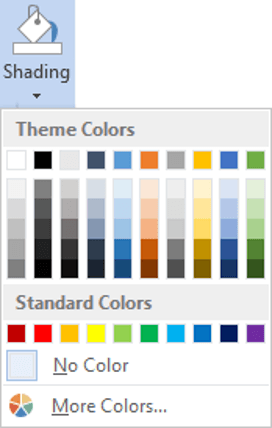
If you cannot find the exact colour you need,
- Click the More Colours link underneath the palette. This displays a larger, more accurate colour palette.
- And if that’s not enough, click the Custom tab and you’ll get a really fine selection of colours (you can even enter your own RGB settings if you know them)
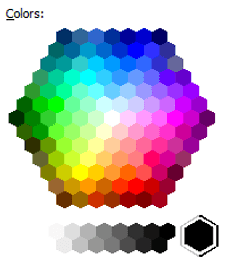
9. REPEATING table HEADINGS ON EVERY PAGE WHEN PRINTING
When you have large tables that occupy two or more pages, many people insert manual page breaks, then copy and paste their table header rows at the top of each page.
When rows are added or removed from tables in Word, the table headers end up half way down the page.
There is a simple tool that will eliminate this problem
1. Ensure that the table is a single table, with no manual page breaks in the middle, and one header at the top. The table header may occupy more than one row, it doesn’t affect the way this feature works.
2. Position the cursor somewhere in the top row of the table.
3. Select the Layout tab under the Table Tools banner.
4. Click the Repeat Header Rows icon ion the Data group.
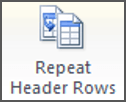
Now, it doesn’t matter how many rows tables in Word contain, if the table ever spills across into another page, the header row (which normally displays the column headings) will always appear at the top of the table.
10. All the key points again
- Tables in Word serve 2 distinct purpose: to display a table of data and to organise and position items on the page
- To create table, select 2 tabs - Design and Layout under the Table Tools banner.
- There are 2 tabs - Design and Layout under the Table Tools banner.
- You can press the TAB key to move direct to the next cell and SHIFT and TAB together to move backwards through a table.
- The four elements of a table are cells, rows, columns and the whole table. Each can be selected.
- Rows can be inserted by selecting the Layout tab under Table Tools , then clicking the Insert Above or Insert Below icons. Alternatively, hover to the left of a row and click the plus symbol that appears above or below the mouse pointer.
- Columns can be inserted by selecting the Layout tab under Table Tools , then clicking the Insert Left or Insert Right icons. Alternatively, hover above a table column and click the plus symbol that appears to the left or right of the mouse pointer.
- Columns and rows and be removed from the table, by positioning the cursor in the row or column to be removed, then clicking the Delete icon on the Layout tab of Table Tools and choosing Delete Row or Delete Column .
- Tables can be formatted using the Table Style gallery or by manually setting the shading and borders manually. Both sets of tools are found on the Design ribbon of the Table Tools .
- When using the Microsoft Table Styles , you can control the behaviour of the formatting by setting the Table Style options – 6 tick boxes that define the structure of your table.
- For long tables that spill across onto subsequent pages, the top row, which normally contains the column headings can be set to repeat automatically . So there is no excuse for cutting and pasting headings midway through your table or taping pages together to make sense of the table!
I hope you found plenty of value in this post. I'd love to hear your biggest takeaway in the comments below together with any questions you may have. Have a fantastic day.

About the author
Jason Morrell
Jason Morrell is a professional trainer, consultant and course creator who lives on the glorious Gold Coast in Queensland, Australia.
He helps people of all levels unleash and leverage the power contained within Microsoft Office by delivering training, troubleshooting services and taking on client projects. He loves to simplify tricky concepts and provide helpful, proven, actionable advice that can be implemented for quick results.
Purely for amusement he sometimes talks about himself in the third person.
Word Pro Tips
Multilevel numbering in Word that works perfectly, first time
Word Beginner
An Express Tour of the Word Screen. Getting Started with Microsoft Word: A Beginners Guide
JOIN THE DISCUSSION
Session expired
Please log in again. The login page will open in a new tab. After logging in you can close it and return to this page.
- Trending Now
- Foundational Courses
- Data Science
- Practice Problem
- Machine Learning
- System Design
- DevOps Tutorial
Working with Tables in MS Word
Microsoft Word or MS-WORD is a graphical word processing program that users can type with. It allows the users to type and save documents very similar to other word processors. There are many versions of MS-word in market, which the user can install as per te. In this tutorial, we will learn about the tables in MS-Word.
Tables in MS Word are made up of rows and columns with an organized arrangement of text. These tables can be used to align numbers in columns and then various operations can be performed on them. Tables can also be used to create page layouts. Rows in a table are series of data banks laid out horizontally in a table or spreadsheet. Columns are vertical series of cells in a chart, table, or spreadsheet.
How to Create a Table?
Tables in MS Word can be created in the following two ways:
1. Using the Grid
2. Using Table Dialogue Box
Using the Grid
Following are the steps of creating a table using the Grid provided in MS Word:
Step 1: Go to the Insert tab and click on the Table button.

Step 2: In the dropdown menu, select the number of rows and columns from the Grid.

Using Table Dialogue Box
Following are the steps of creating a table using Table Dialogue Box in MS Word:
Step 2: Under the grid, you will see an Insert Table button. Click on it.

Step 3: In the Insert Table Dialogue box, mention the number of rows and number of columns as per the requirement and click on OK button.

How to Modify a Table?
We can also edit/modify a table to make it more creative. Multiple operations can be performed on a table like changing the layout, splitting of cells, merging the cells, applying borders, etc. Here, we will see some of the operations performed on a table in MS Word.
Changing Layout of a Table
Changing the layout of a table can be done with the help of the following steps:
Step 1: Select the table for which the layout is to be changed. Go to the design tab .

Step 2: Click on the dropdown menu to get various different types of layouts for your table.

Step 3: Select any layout as per the need.

Splitting the Cell
Splitting of a cell can be done with the help of the following steps:
Step 1: Select the cell that you want to split into multiple cells. Then go to the Layout tab and click on the Split Cells button.

Step 2: In the dialogue box , mention the new dimensions as per the requirement.

Step 3: Click on the Ok button.

Merging the Cells
Merging of various cells can be done by the following steps:
Step 1: Select all the cells that are to be merged into a single cell. Then go over the layout tab, and you will see a Merge Cell button.

Step 2: Now click on the Merge Cell button and the selected cells will be merged.

Applying Borders and Styles on a Table
Borders and styles can also be applied to a table in a similar way as the layout of a table is changed. Go through the following steps to do the same:
Step 1: Select the entire table and go over the design tab.

Step 2: Select the style that you want to apply to your table.

Converting Text to a Table
MS Word allows the conversion of existing text into a table with the help of the following steps:
Step 1: Select the text that is to be converted into the table. Now go to the Insert Tab and you will see a Table button.

Step 2: Click on the Insert Table button and in the drop-down menu, click on the Convert Text to Table button.

Step 3: In the dialogue box, mention the dimensions of the required table and other data that is required.

Step 4: Click on the OK button and the selected text will be converted to a Table.

Inserting Images in a Table
MS Word allows adding images inside the table cells. To insert an image in a table, go through the following steps:
Step 1: Select the cell in which you want to add the Image. Go to the Insert tab and select the Pictures button.

Step 2: You can either choose a picture from your device or select one online.
Step 3: Choose a picture from the browser window and click on the Insert button.

Step 4: Selected Image will be added in the cell selected.

Performing Calculations in a Table
Mathematical calculations can also be performed on the values present in the table. Microsoft provides various formulas to perform these operations. By default, the sum of the values lying in the rows to the left or column lying above are calculated by Word. Following are the steps to do the same:
Step 1: Select the cell in which the result of the mathematical operations is required.

Step 2: Now go to the Layout tab and select the formula button.

Step 3: In the dialogue box, define the formula for the mathematical operation, the default formula is the sum of the values to the left or above.

Step 4: After defining the formula, click on the OK button to apply the formula on the cells given in the formula.

Please Login to comment...
Similar reads.
- School Learning
Improve your Coding Skills with Practice
What kind of Experience do you want to share?
Templates for college and university assignments
Include customizable templates in your college toolbox. stay focused on your studies and leave the assignment structuring to tried and true layout templates for all kinds of papers, reports, and more..

Keep your college toolbox stocked with easy-to-use templates
Work smarter with higher-ed helpers from our college tools collection. Presentations are on point from start to finish when you start your project using a designer-created template; you'll be sure to catch and keep your professor's attention. Staying on track semester after semester takes work, but that work gets a little easier when you take control of your scheduling, list making, and planning by using trackers and planners that bring you joy. Learning good habits in college will serve you well into your professional life after graduation, so don't reinvent the wheel—use what is known to work!

Novum Learning
Back to basics: setting up tables in ms word.
6 Modules | 30 minutes | Free
Lawyers - Secretaries - Document specialists
This is the first, foundational course from a three-session MS Word tables masterclass
Word tables made easy
Microsoft Word tables are a common element of professional documents to give a better structure to essential information or format text more efficiently. However, creating tables in Word that are robust is easier said than done. Knowing how to set up the basic foundations is where MS Word table skills start and can advance from rapidly. After doing our foundational online course you will have full confidence setting of tables quickly, moving whole tables and text around and more. MS Word tables need not be an obstacle in professionally formatted Word documents.
Create an MS Word Table correctly in a fraction of the time, utilizing the quick access toolbar
Adjust the rows and columns of your Word tables in just one click with easy to use functions
Make your tables spanning across multiple pages easy to navigate with robust headings that stay at the top of the page even if you add more rows
Move your MS Word tables between pages, sections or entire documents without losing its formatting or damaging your text
Insert text into your table and move it between cells with confidence and no fear of your Word table falling apart
Welcome and set up
Setting the scene
Foundations of a solid table
Setting up a correct and solid frame for you
Relocating tables
Moving tables and some troubleshooting tips
Correct headings on every page
Repeating heading rows on every page without copy pasting
Moving tables in your document
Moving tables within your document and some troubleshooting tips
Inserting text and moving it between cells
Inserting text and moving it within the table
Why settle for less?
Explore the full masterclass courses and work with Microsoft Word tables with confidence
$57.30 Presentation leveled up: Formatting tables in MS Word
$57.30 rising to word table mastery, start learning, what our students have to say....

Practical learning for lawyers
Fiona Canty

Practical and easy to follow Word training
Jennifer Butler

Highly relevant online training courses
Michael Astle
Meet the expert ...

Bluebird Operations Director and Microsoft Specialist
Leanne Bentley
Manage your documents like a pro!
From more Microsoft Word skills through Excel all the way to PDF, there is no better time than now to become highly self-sufficient using fundamental office software.
All courses, Technology, Masterclasses
Self-sufficiency skill set to manage legal drafts in Microsoft Word

All courses, Technology, Free courses
Excel from scratch

Power PDF | A modern Swiss Army Knife

WTO / Personal / Lists / Free Table of Contents Templates (for Microsoft Word)
Free Table of Contents Templates (for Microsoft Word)
Whether you are writing a book, large essay, dissertation, or other longer academic papers, you will have to include a table of contents. It will act as a roadmap for the reader to each portion of your writing. It helps the reader to locate specific information in a document or revisit their favorite parts easily within the text. A well-structured TOC should simplify the way the reader finds what they are looking for and should always be placed on a separate page, just after the first page of an academic paper and after the abstract.
Depending on the type of writing, you may find that different documents require different styles of a TOC. Some may require numbers, while others may require a non-numbered TOC. It is, therefore, the writer’s duty to check the type of TOC they are required to include in their writing.
Free Table of Contents Templates
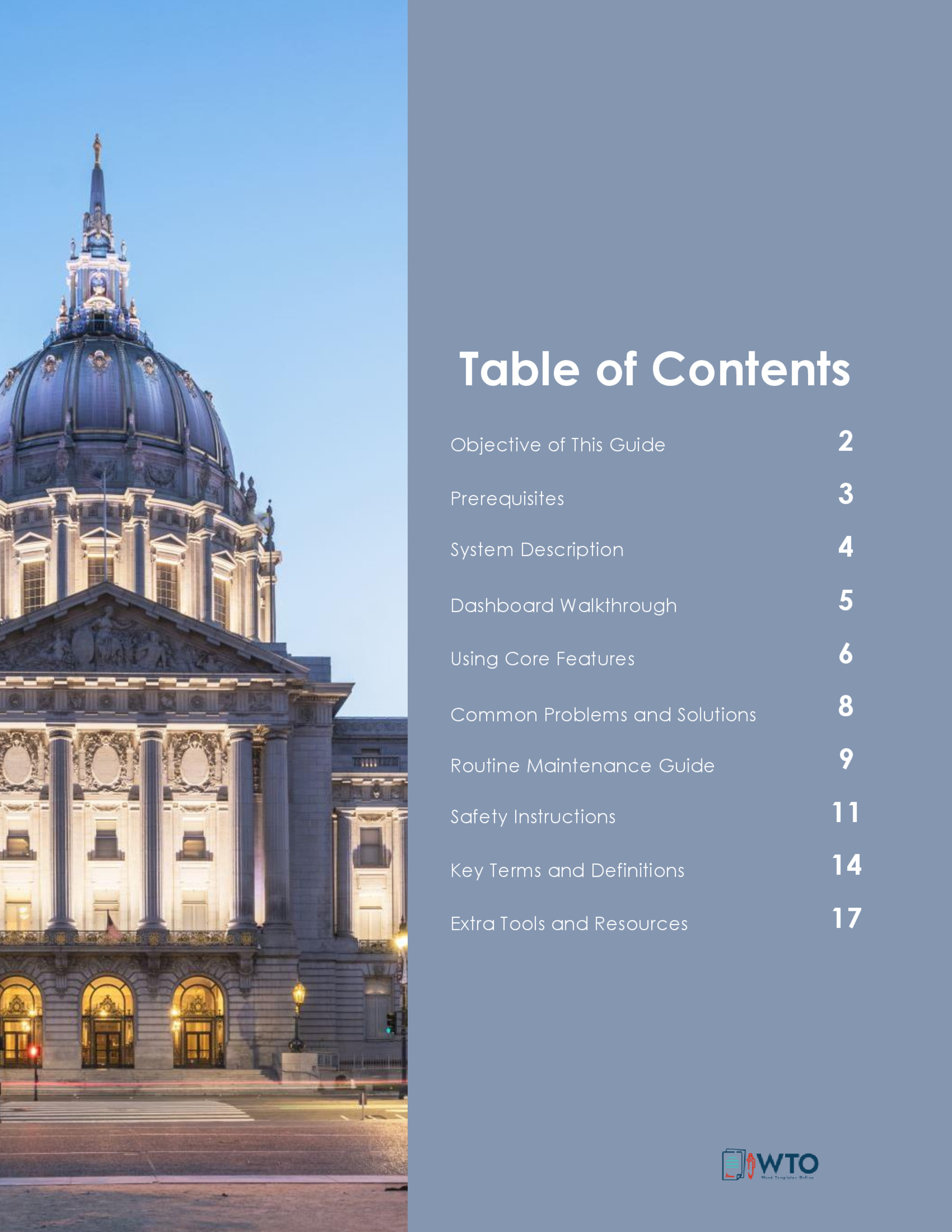
Simple templates
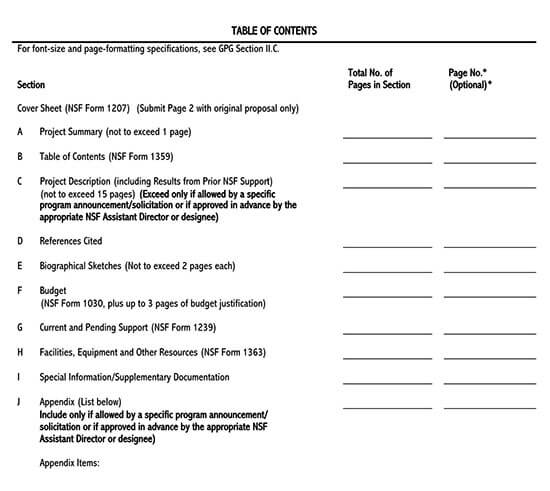
What is a Table of Contents?
A Table of Contents (TOC) is an organized list of all the parts of a document or book organized in the order in which the parts appear.
The TOC usually contains the titles, chapters, figures, and major sections of a document clearly labeled by their page number. It should be added last or updated after completing the whole document or book to capture all the contents accurately.
The Purpose of table of contents
If a book, business proposal , business report , or publication is long enough to include chapters, then a TOC will likely be included at the beginning of the book, report, or publication.
The TOC provides a sequential list of the book’s organizational structure, most commonly denoting the title, chapter number, and the starting page location. The chapter, page number, and title will help guide the reader in finding specific sections.
Basically, it serves two main purposes; one is to provide the reader with a general overview of what is contained in the document and how the content is organized, and the other is to enable the reader to go directly to the specific section of an on-line document.
Key Elements of a Table of Contents
The TOC is where one lists the chapters and major sections of their document, together with their page numbers. A clear and well-out table is very important as it indicates a quality paper is structured.
The key elements that should be included in the TOC are:
- The page titles
- Clear headings and subheadings
- The page numbers that show where in the document each section can be found
When creating your table, make sure to include all level one and two headings. You may also decide to include level three headings, although they are optional to include and should not be included in the TOC has reached its maximum length of two pages.
Level One: CHAPTER 2: Literature Review
Level Two: 2.1 Overview of Information
Level Three: 2.1.1 Discipline of Knowledge
Ensure that you use clear headings throughout your document to make your table easy to understand. Keep in mind that the reader will see the table first before reading through your document.
Other things to include in your table include the appendices and tables. Including these two, however, depend largely on how many there are in your document.
If there are more than three tables and figures, you might consider listing them on a separate page. Else, you can include them in your table.
Steps to Create a Table of Contents in MS Word
For you to create a TOC in Microsoft Word, you must first define what you’d like to include in this part. First, start off by applying the different heading styles throughout your document.
Once you’ve done that, follow these steps to insert a TOC in MS Word automatically:
Add a title on the TOC page. Ensure that you follow the standard format specific to your document or as per your department’s guidelines.

Put your cursor where you want the table to go. The table is usually included between the abstract and the introduction.
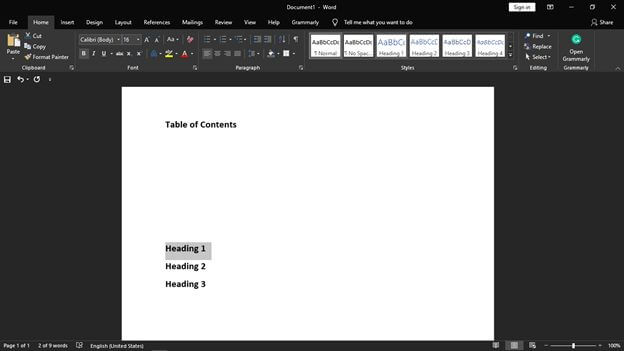
In the ribbon, find the reference section and locate the TOC section. Use the search tab on the ribbon to search for the table.
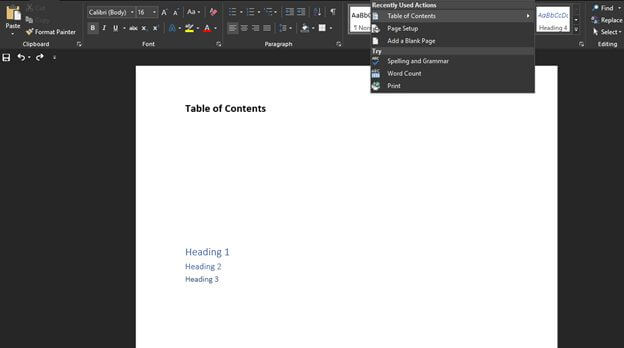
Click the arrow that is next to the TOC icon and select Custom Table of Contents. Here, select the level of heading that you would like to include in your table and also make the necessary adjustments to each level by clicking the modify button.
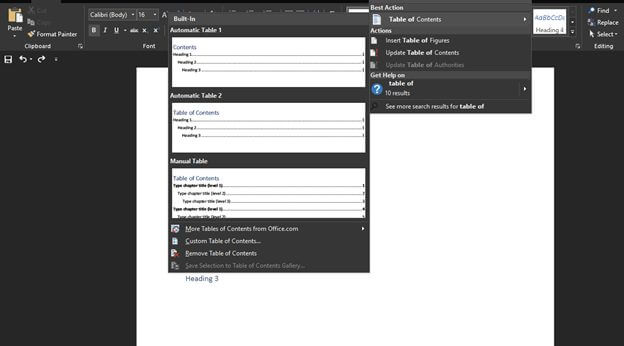
Click on Custom table of contents.
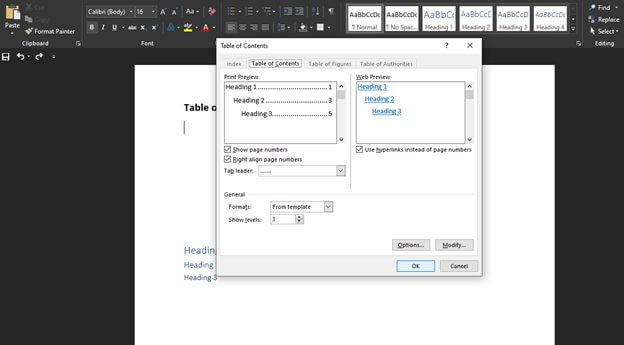
After you’ve made sure that everything is OK. Click OK, and your TOC will be automatically generated.
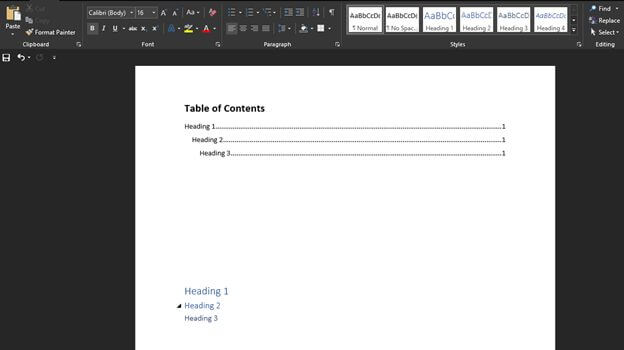
Tips on Preparing Table of Contents
It is recommended that you use your TOC template last after to make sure that it provides a clear overview of your document. You can still draw up a mock TOC in your early stages of writing to help you formulate a structure and think through your topics and how you are going to research.
Make sure that all the heading levels are properly defined in your document before inserting the template.
Remember that the reader will most likely go through your table first before diving into the document to get an overview of what to expect. Make sure that your TOC is clear and that it captures your entire document.
Frequently Asked Questions
No, the TOC is basically a snapshot of the headings, tables, and page numbers in a document and does not automatically update itself as you make changes. Anytime you make changes to your document, you can update it by simply right-clicking on it and selecting the update field.
No, the TOC is usually included between the abstract and the introduction.
Yes, the maximum length of a TOC should be two pages, regardless of the type of document you are writing.
Regardless of your document’s type or size, using a TOC can help direct the readers to exactly where they want to be. Other than making your document more reader-friendly, the table also makes it easier for the author to go back and change or update contents throughout their document if necessary. By default, MS Word generates a TOC when you use the first three built-in heading styles, i.e., Heading 1, Heading 2, and Heading 3. To apply the different heading styles, simply select the style from the “Home” tab, or you can use a TOC template. Once you’ve properly defined the heading styles, follow the procedure given above to insert your table automatically.
About This Article

Was this helpful?
Great! Tell us more about your experience
Not up to par help us fix it, keep reading.

30 Great Persuasive Essay Examples | Guide & Tips

Education , Planners
20 free unit plan templates | word – pdf.

Charts , Education
22 free printable homework planners (templates).

43 Printable Division Worksheets (for Grade 4-6) | Word, PDF
Thank you for your feedback.
Your Voice, Our Progress. Your feedback matters a lot to us.
Subject Explorer
School Subjects
Math & Science
Business & Technology
Electives & Health
Board & Administration
Teaching & Learning
Audio/Video Lectures
Books & Documents
Classifieds
Jobs & Resources
Discussions
Language & Literature
Word 10 Table
In this practice project for Word, students create a document with a title and two identical tables. These tables have a larger column on the left with student names. The remaining cells are identical in size and empty, making a chart to track completion of homework.
Sign in to rate this resource.
Categories:
Resource Type:
Pass it on:
Related Items
More from this series: practice projects for microsoft word.
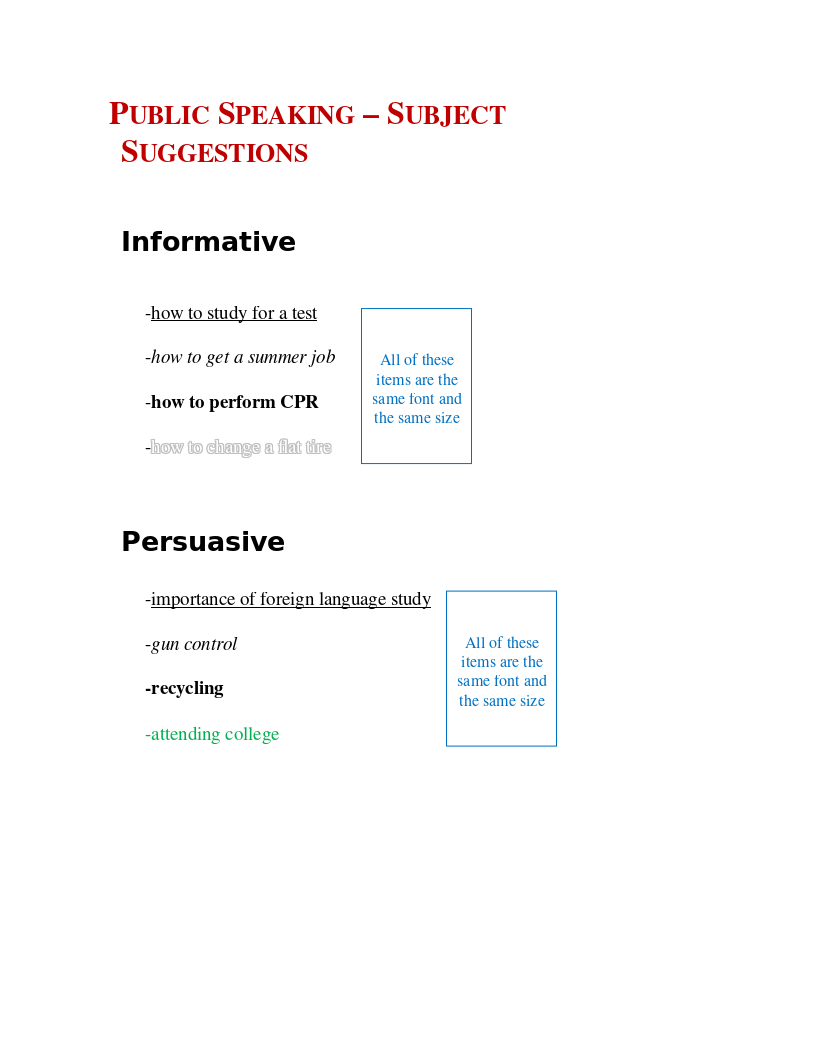
Word 21 Formatting Options
In this practice project for Word, students create a document that shows some different effects that can be used with the same font. …
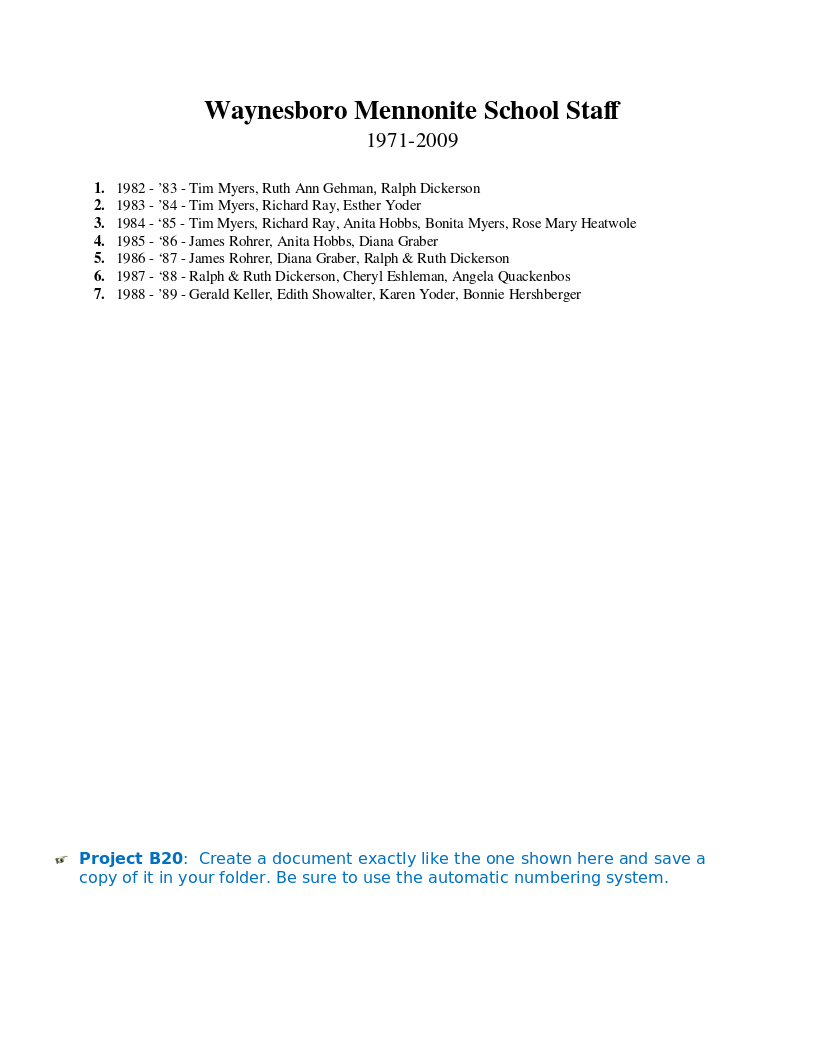
Word 20 Numbered List
In this practice project for Word, students create a document that includes a centered title followed by a numbered list. …
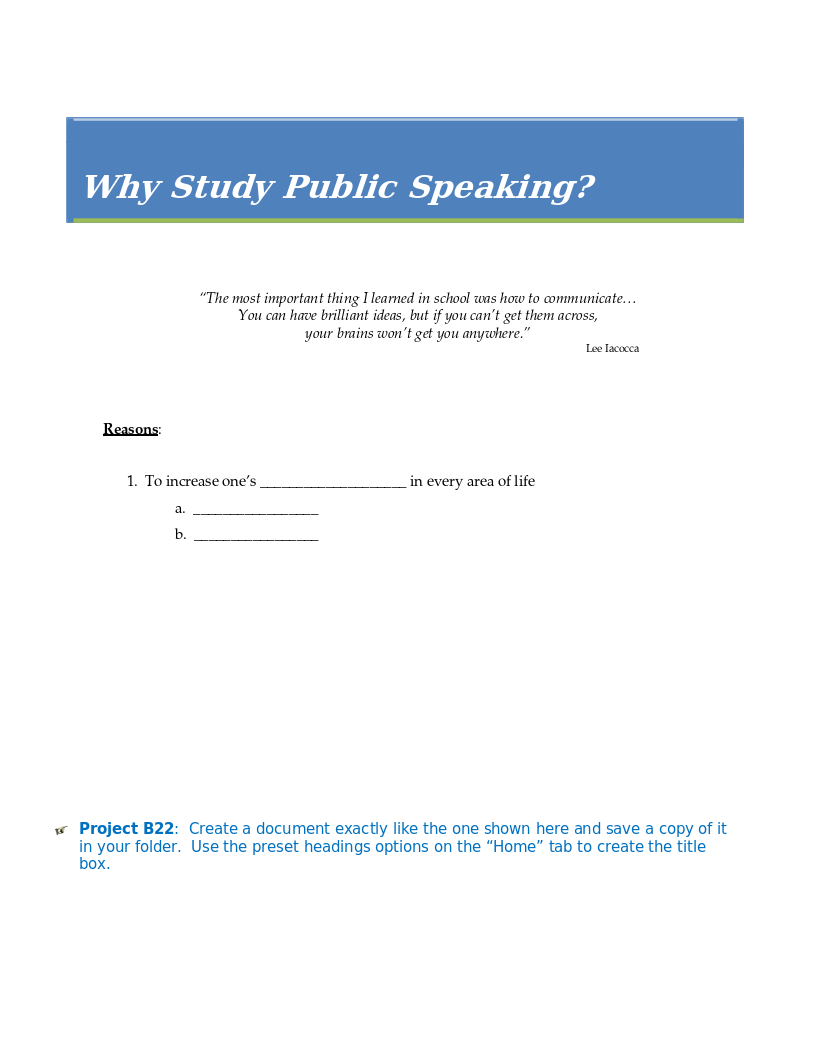
Word 22 Preset Headings
In this practice project for Word, students create a document using the preset headings to create a title bar. The document has different alignment and font, blanks, and a short outline. …
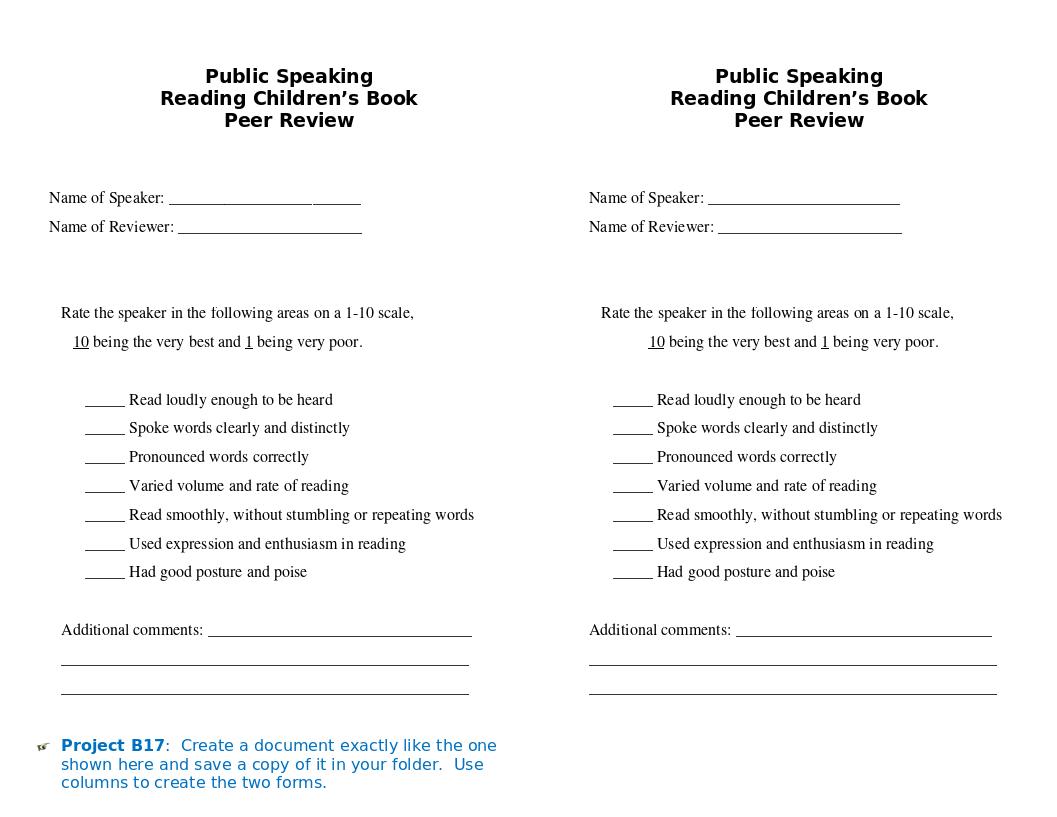
Word 17 Columns
In this practice project for Word, students create a document with two identical columns in landscape orientation. Included in each are indented lines and different alignment and font. …
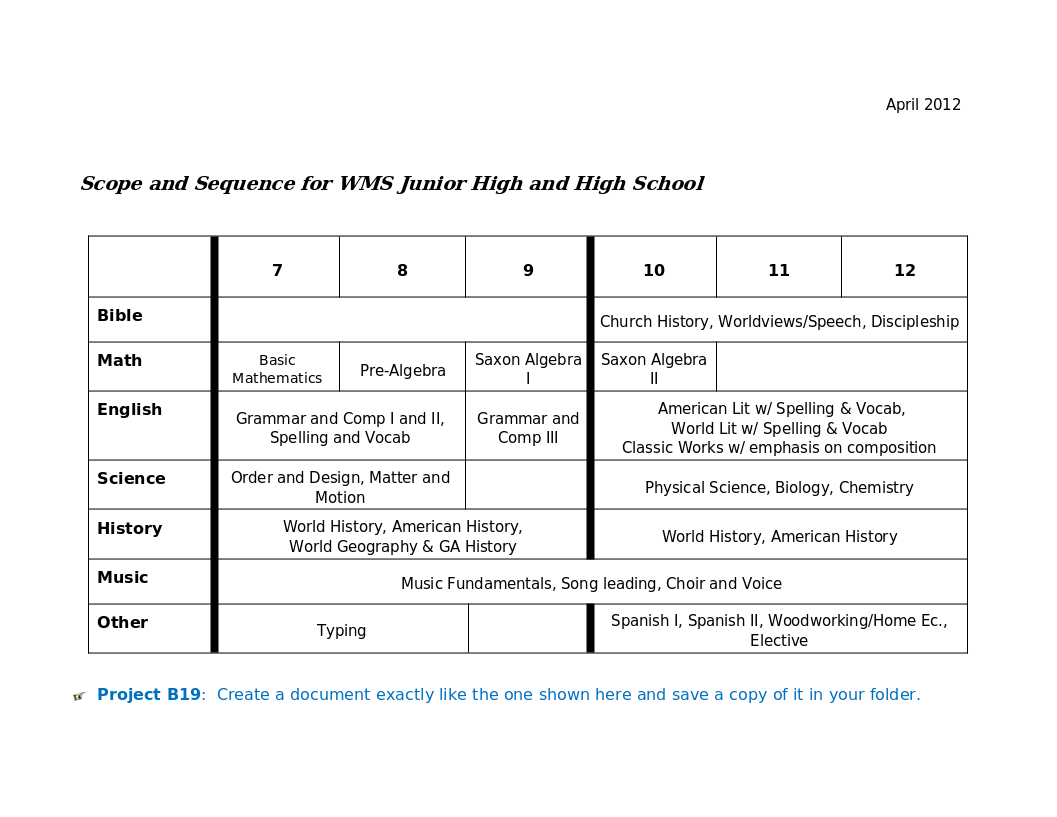
Word 19 Advanced Table
In this practice project for Word, students create a document with a table showing a school schedule. The blocks in the table are different sizes and will take individual work within the blocks to …
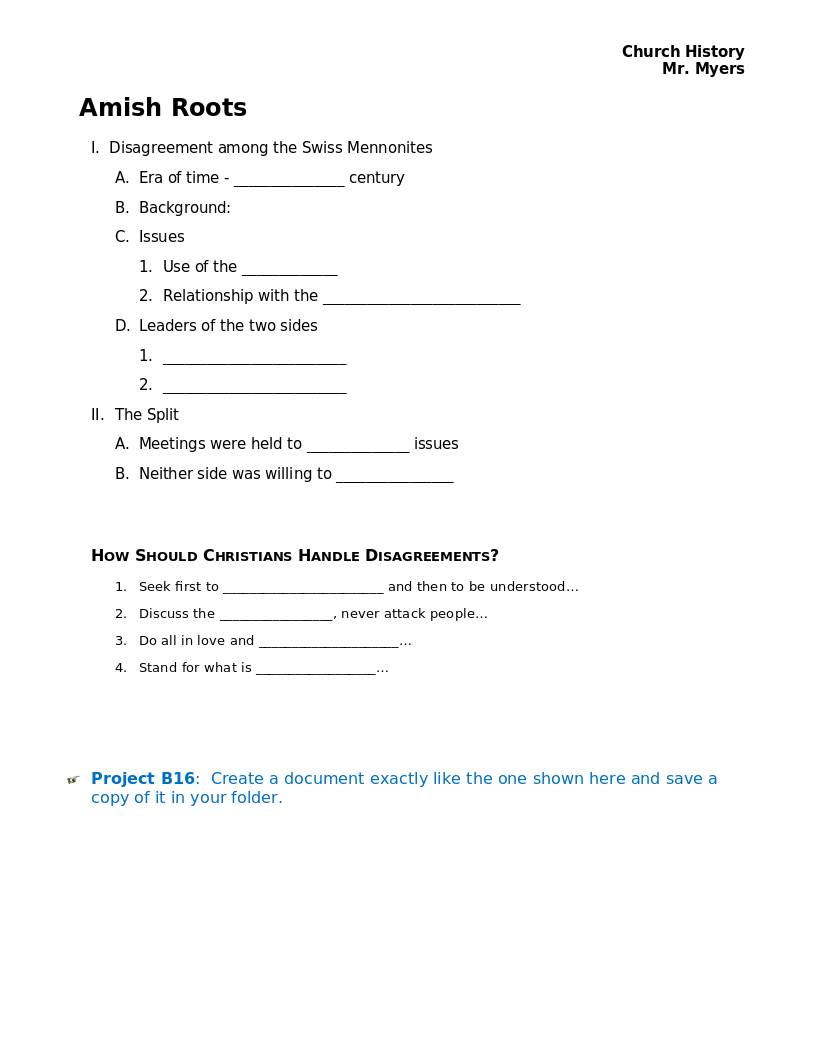
Word 16 Lesson Notes Handout
In this practice project for Word, students create a document like a student handout. This includes an outline with several levels, blanks for students to write on, and different font. …
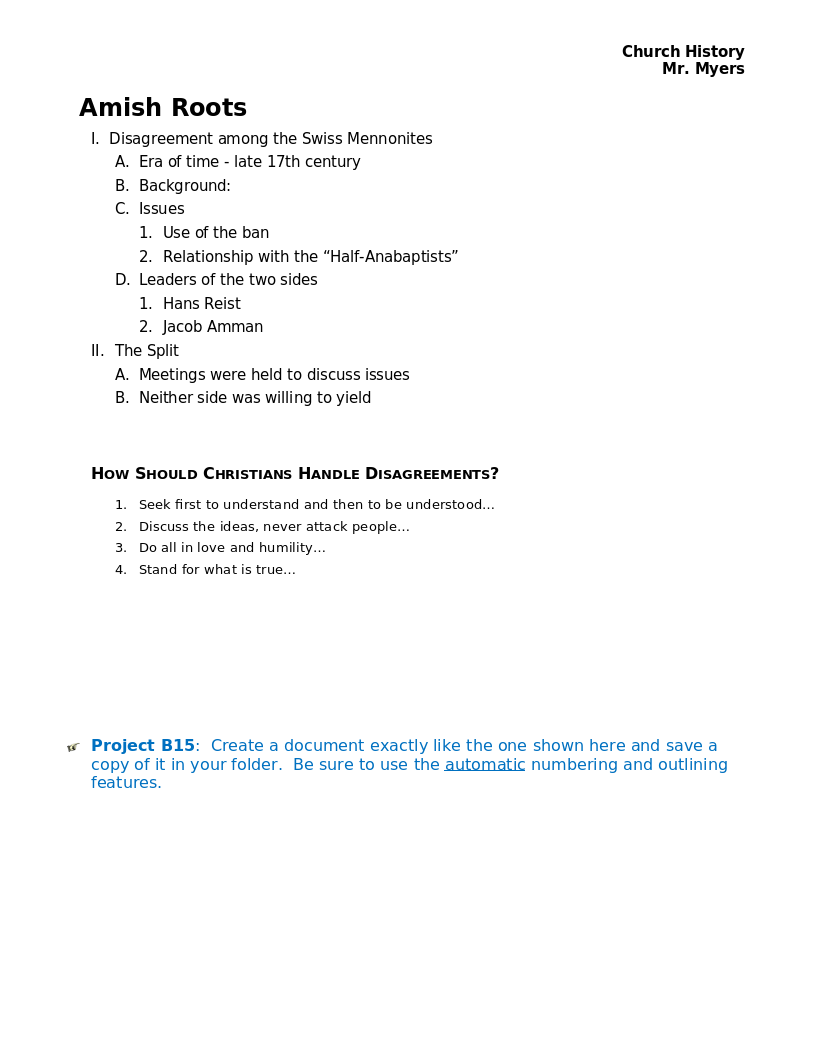
Word 15 Lesson Notes
In this practice project for Word, students create a document with a header and two outlines. Students are asked to use the automatic numbering and outlining features in Word. They must use different …
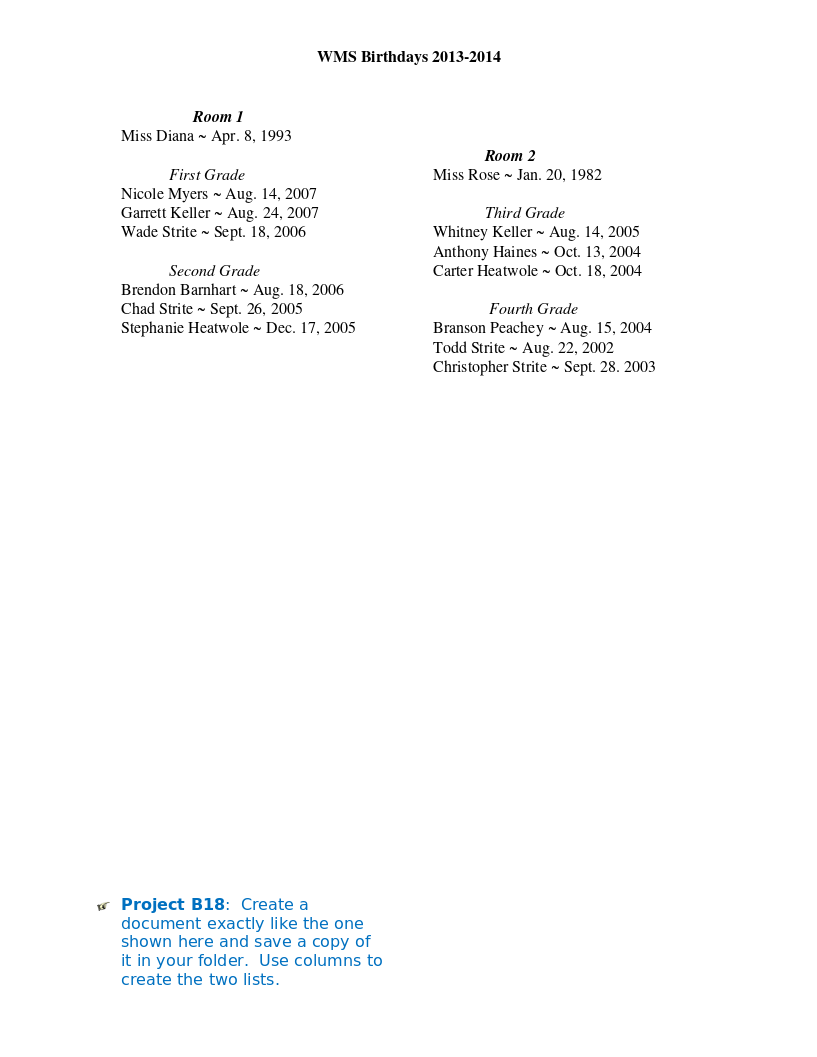
Word 18 Columns
In this practice project for Word, students create a document with a header and two colomns. The columns include boldfaced and italic font and different alignment. …
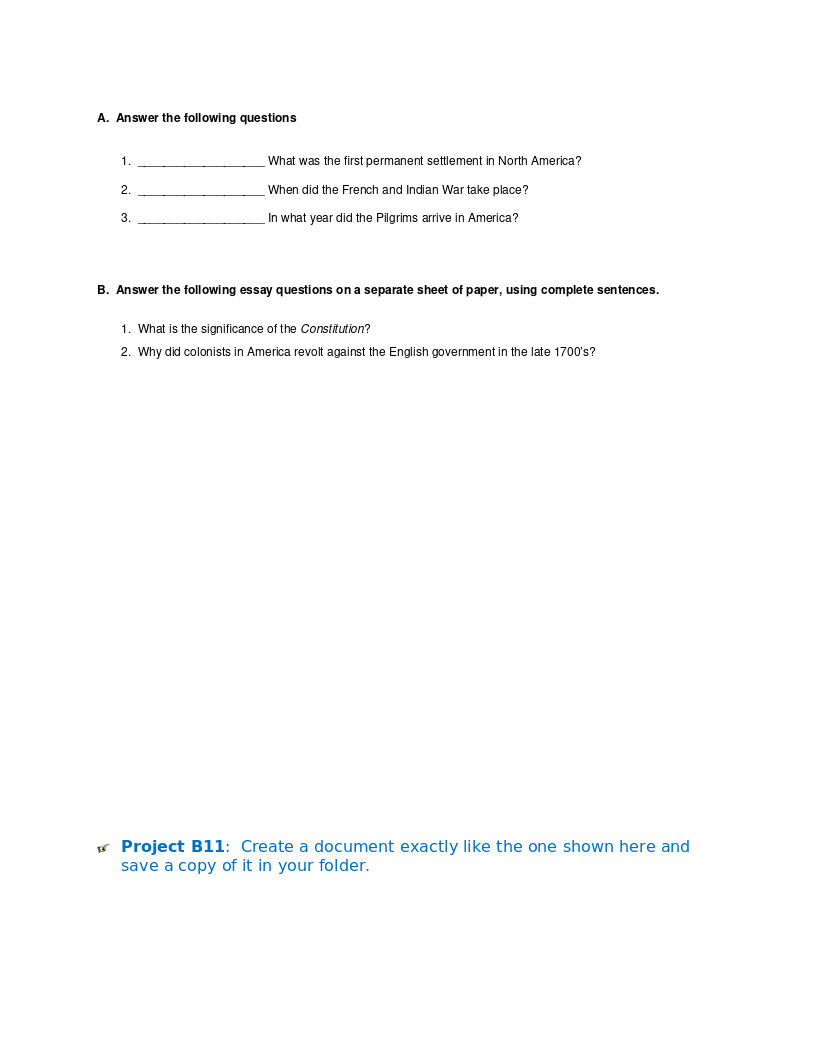
Word 11 Formatting
In this practice project for Word, students create a document similar to a test or quiz. They must include points and subpoints, blanks, boldfaced text, tabs, and spacing. …
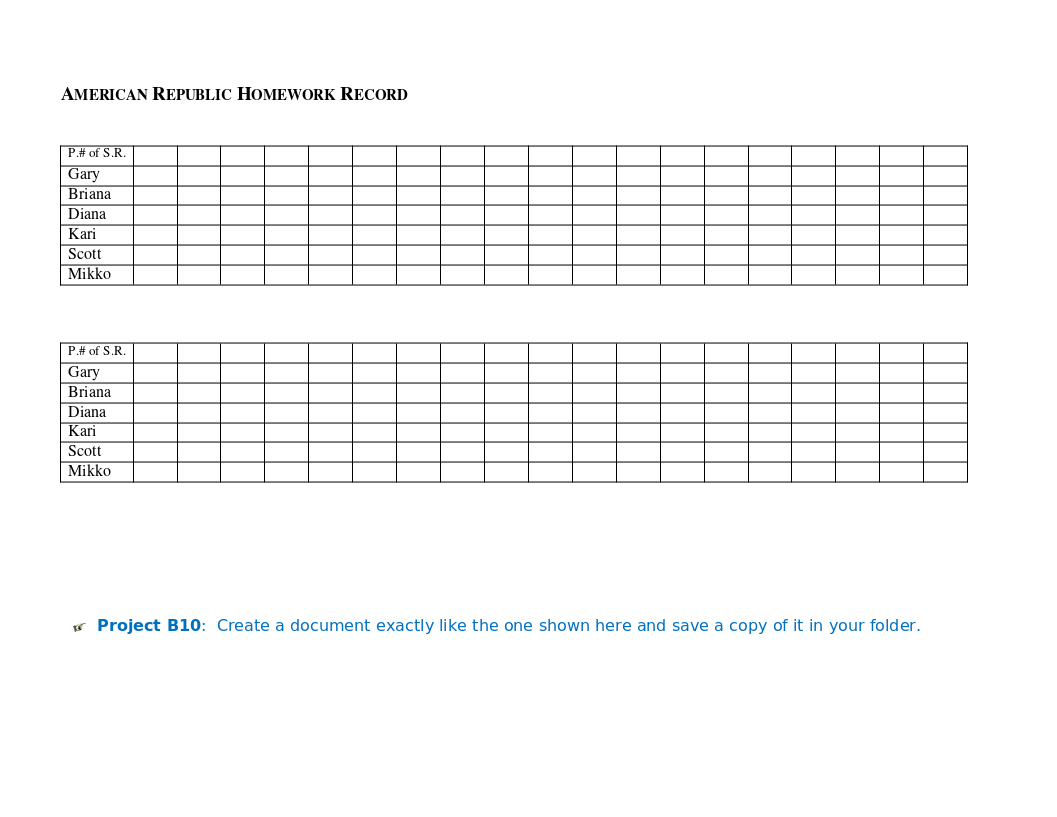
In this practice project for Word, students create a document with a title and two identical tables. These tables have a larger column on the left with student names. The remaining cells are …
Leave a Reply

IMAGES
VIDEO
COMMENTS
Select the list, go to Insert, Tables, and choose the Convert Text to Table option. In the dialog box, make sure that Commas are selected under the Separate text at the panel. Then click OK . Word will do the conversion for you, and a table will appear. You can then use the Table Design and Layout tabs to modify it.
For this assignment, you will format a document with a table and an image. Follow the directions, then submit your assignment. If you get stuck on a step, review this module or previous modules and ask your classmates for help in the discussion forum. Download the report document and open it in Microsoft Word.
Word 11 Formatting. ★★★★★. Kendall Myers November 15, 2017. In this practice project for Word, students create a document similar to a test or quiz. They must include points and subpoints, blanks, boldfaced text, tabs, and spacing. …. 1 2.
In this comprehensive tutorial, you'll learn everything you need to know about creating and formatting tables in Microsoft Word. Whether you're a beginner lo...
Place your cursor where you want to insert the table. Select the Insert tab in the ribbon (see figure 1). Select the Table button in the Tables group (see figure 2). Select Insert Table from the drop-down menu. Figure 4. Insert Table option.
Place the insertion point where you want the table to appear. Navigate to the Insert tab, then click the Table command. This will open a drop-down menu that contains a grid. Hover over the grid to select the number of columns and rows you want. Click the grid to confirm your selection, and a table will appear.
Go to Table Properties > Row > Enter a value in the Specify height box. For Row height is select Exactly from the dropdown. Now, select the Table tab > click the Options button > uncheck the Automatically Resize to Fit Contents check box. Click OK twice to exit the Table Properties dialog box.
Download the free course exercise files to follow along ️ https://www.simonsezit.com/adv-word-2019-instructor-files/ In this Microsoft Word tutorial, we t...
read the accompanying article on Using Tables in Word, go here: ️https://www.simonsezit.com/article/using-tables-in-word/Tables play a significant role whe...
2. How to create TABLEs in Word. 1. Select the Insert tab. 2. Click the Tables icon in the Tables group. 3. Move your mouse pointer into the table grid until the required number of rows and columns are highlighted orange, then left-click. An empty table is inserted into the document.
It also presents the Word feature of creating, modifying and formatting charts. The students will learn the following skills: Inserting and modifying a table. Editing tables. Inserting Rows, Columns and Cells. Deleting Rows, Columns and Cells. Sorting Data in a Table. Calculating Data in a Table.
Following are the steps of creating a table using Table Dialogue Box in MS Word: Step 1: Go to the Insert tab and click on the Table button. Step 2: Under the grid, you will see an Insert Table button. Click on it. Step 3: In the Insert Table Dialogue box, mention the number of rows and number of columns as per the requirement and click on OK ...
29.8 KB Creating Tables - Exercise Solution.docx. 31.4 KB. Inserting Pictures and Clip Art. Tables provide a structure of columns and rows to help the user line up data, similar to a spreadsheet layout, but within a Word document.
Templates for college and university assignments. Include customizable templates in your college toolbox. Stay focused on your studies and leave the assignment structuring to tried and true layout templates for all kinds of papers, reports, and more. Category. Color. Create from scratch. Show all.
Create an MS Word Table correctly in a fraction of the time, utilizing the quick access toolbar. Adjust the rows and columns of your Word tables in just one click with easy to use functions. Make your tables spanning across multiple pages easy to navigate with robust headings that stay at the top of the page even if you add more rows.
Apply any table style. Download this image to your computer. Insert the shopping cart image into the document at the beginning of the first paragraph (It starts with "Retailing is important to understand"). Apply a square text wrap and move the image so it is aligned with the right side of the document. Optional: Resize the image.
Table Mazes Using Microsoft Word. For Teachers 5th - 8th. Learners use the table feature of Microsoft Word to construct a solvable maze. They incorporate clip art and WordArt into their mazes. Students create a table and use word processing functions to design a maze.
A table is a grid with rows and columns of cells. Tables can be used for many different things, like showing text information and numbers. In Word, you can make a blank table, turn text into a ...
Step 4: Click the arrow that is next to the TOC icon and select Custom Table of Contents. Here, select the level of heading that you would like to include in your table and also make the necessary adjustments to each level by clicking the modify button. Click on Custom table of contents.
Word 10 Table. ★★★☆. Kendall Myers November 15, 2017. In this practice project for Word, students create a document with a title and two identical tables. These tables have a larger column on the left with student names. The remaining cells are identical in size and empty, making a chart to track completion of homework.
Microsoft W ord is a word processor developed by Microsoft. It was first. released in 1983 under the name Multi-T ool W ord for Xenix systems. MS. W ord is a popular word-processing program used primarily for creating. documents such as letters, brochures, learning activities, tests, quizzes and. students' homework assignments.
ms-word-practical-assignment-pdf - Free download as PDF File (.pdf), Text File (.txt) or read online for free. This pdf contains practical assignment of MS Word.